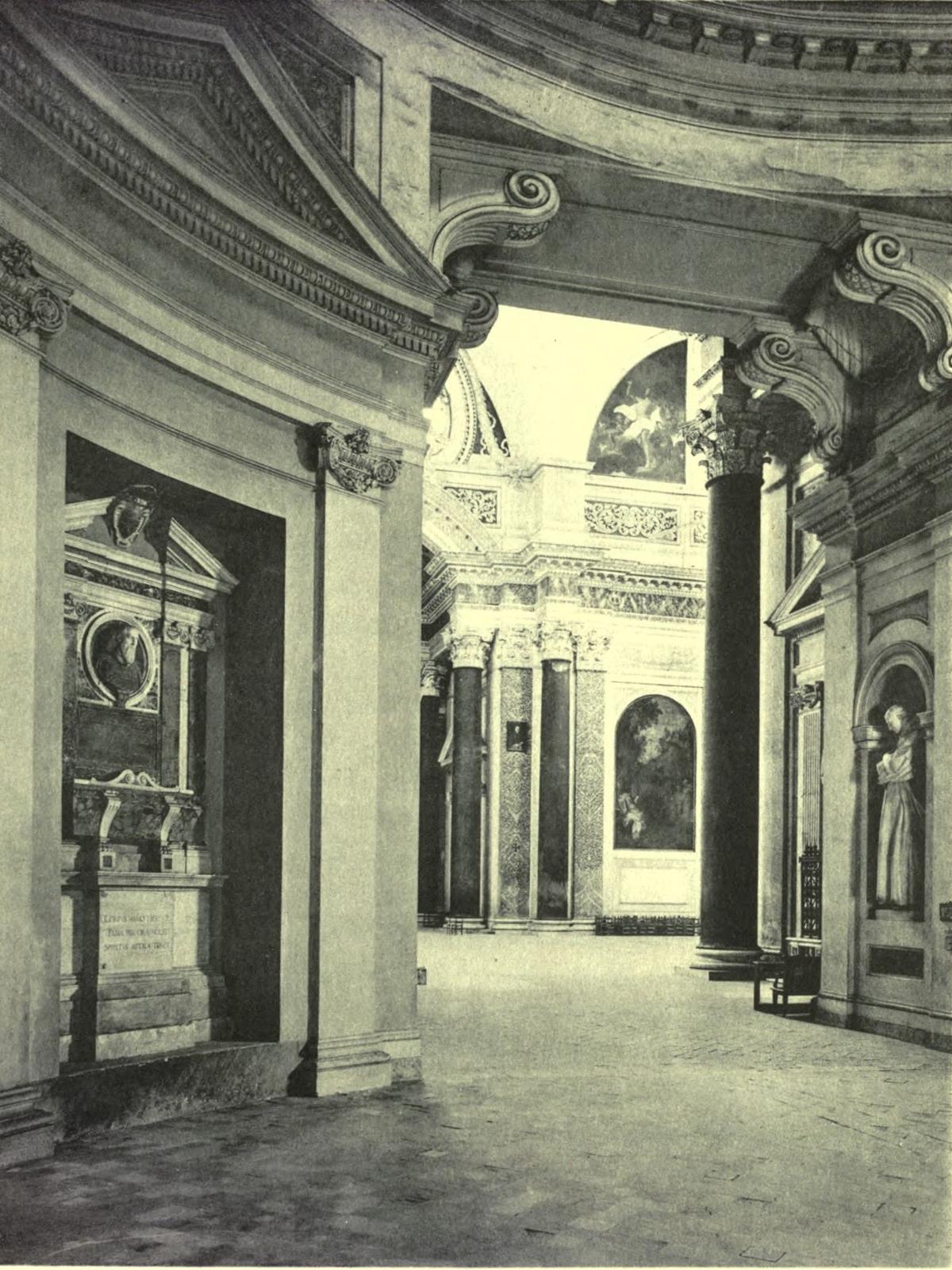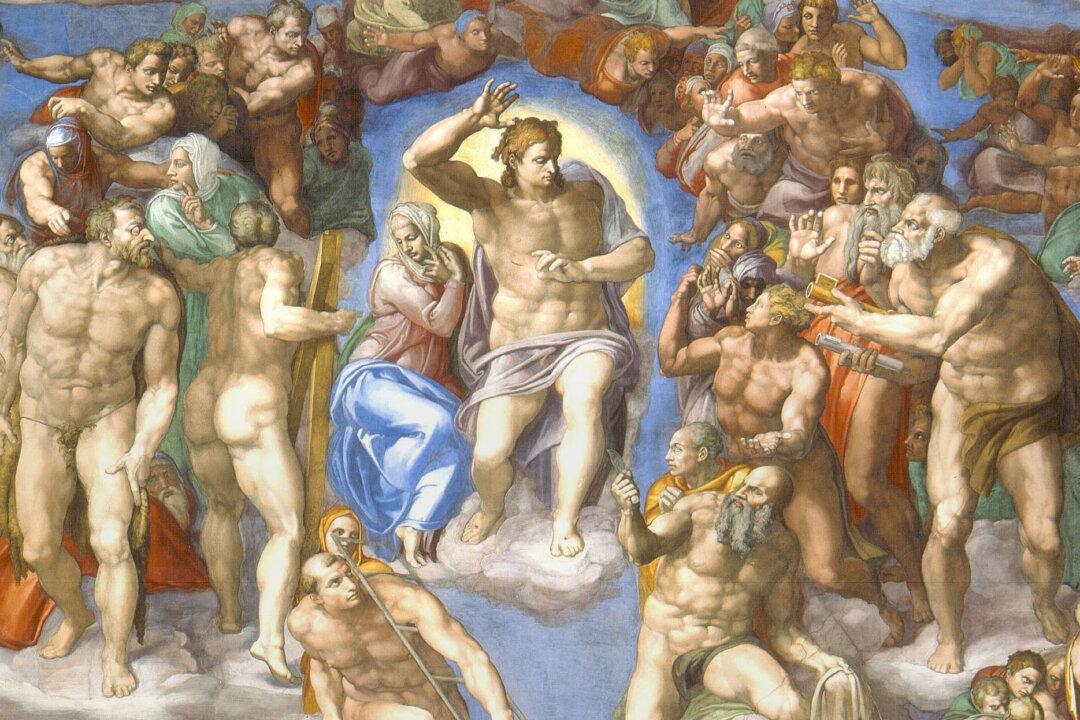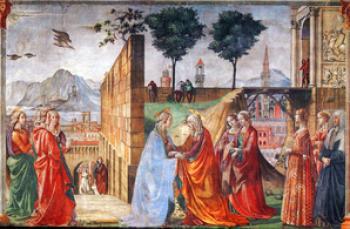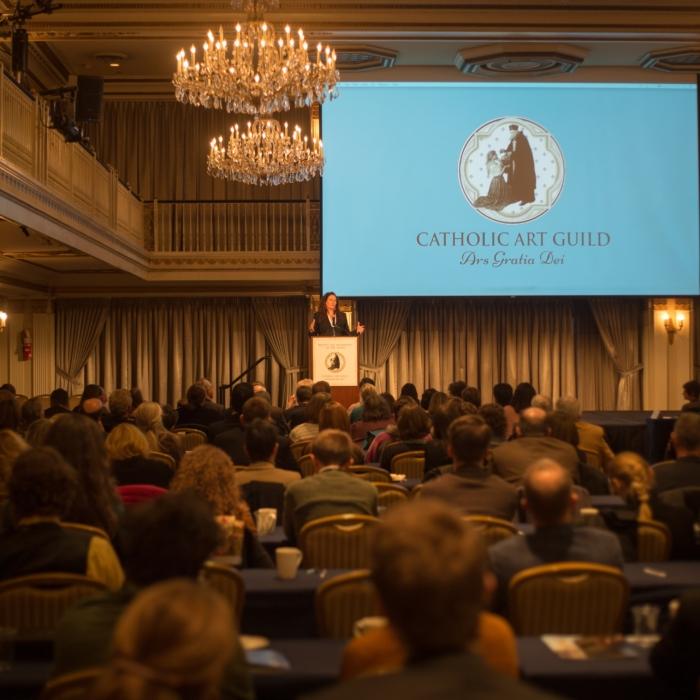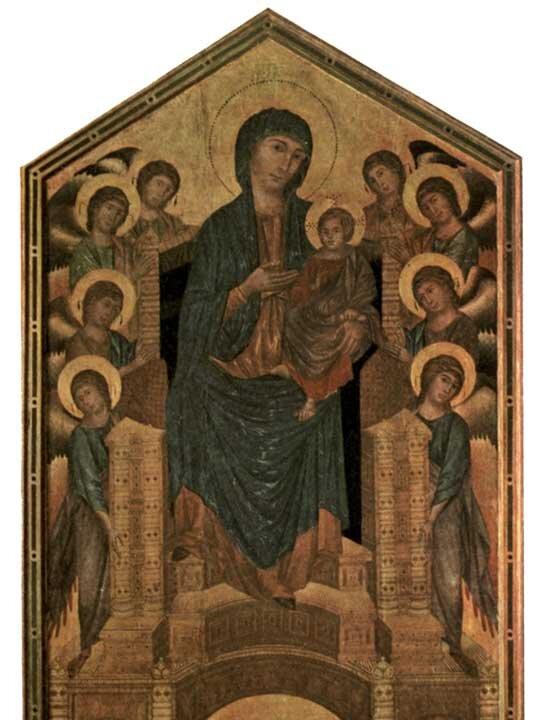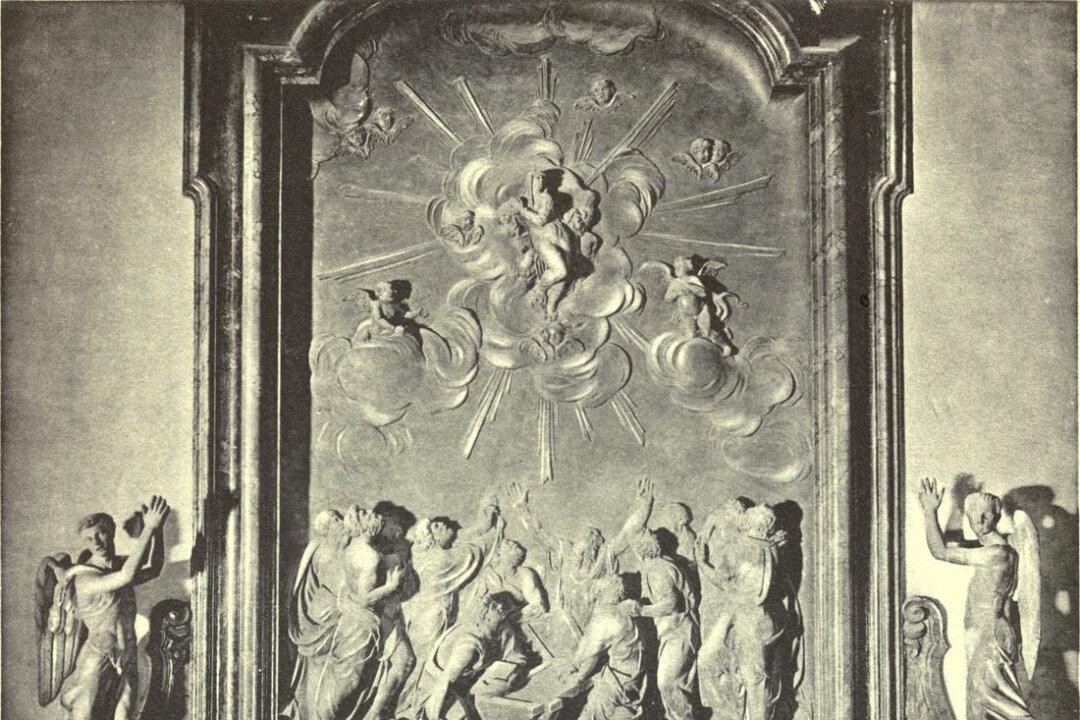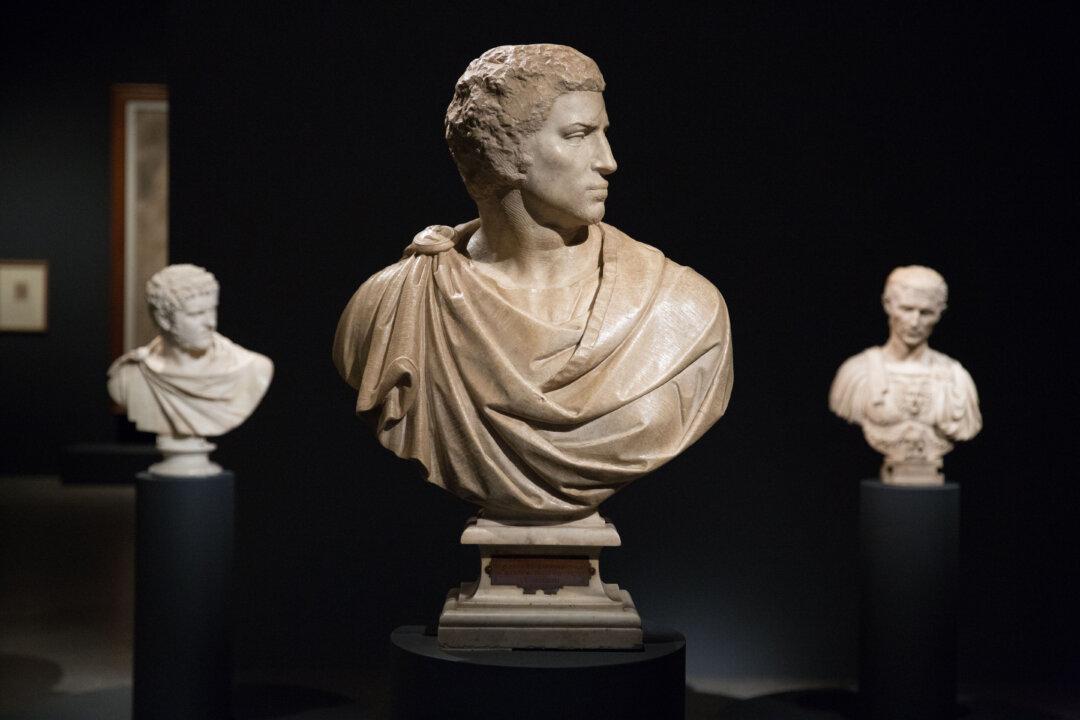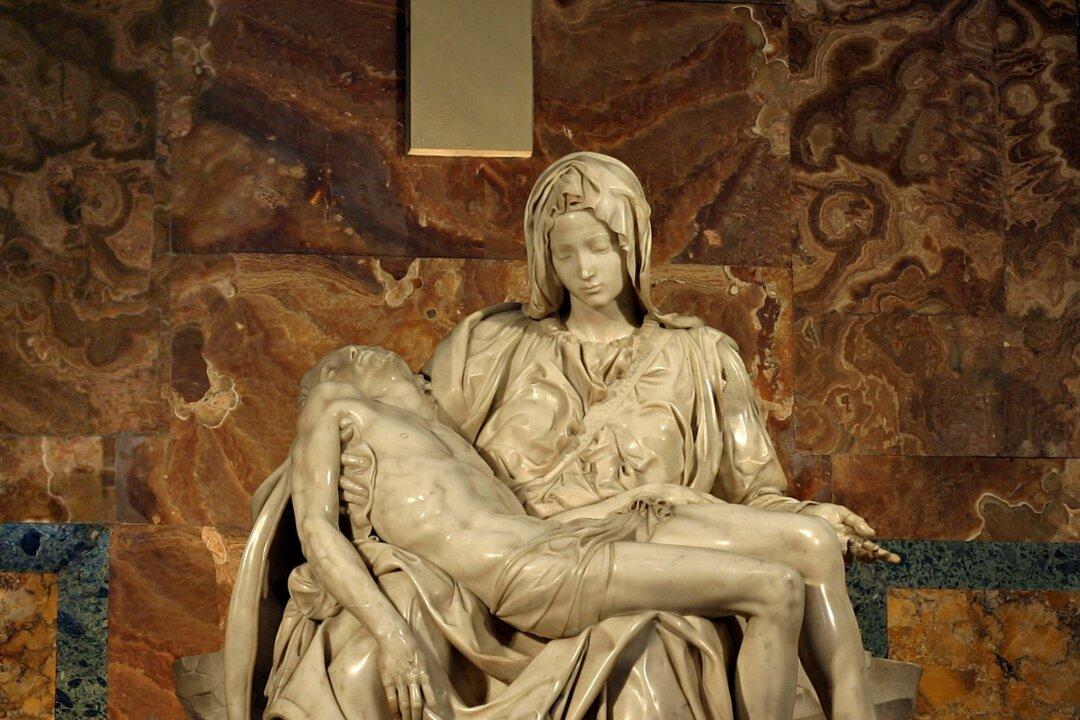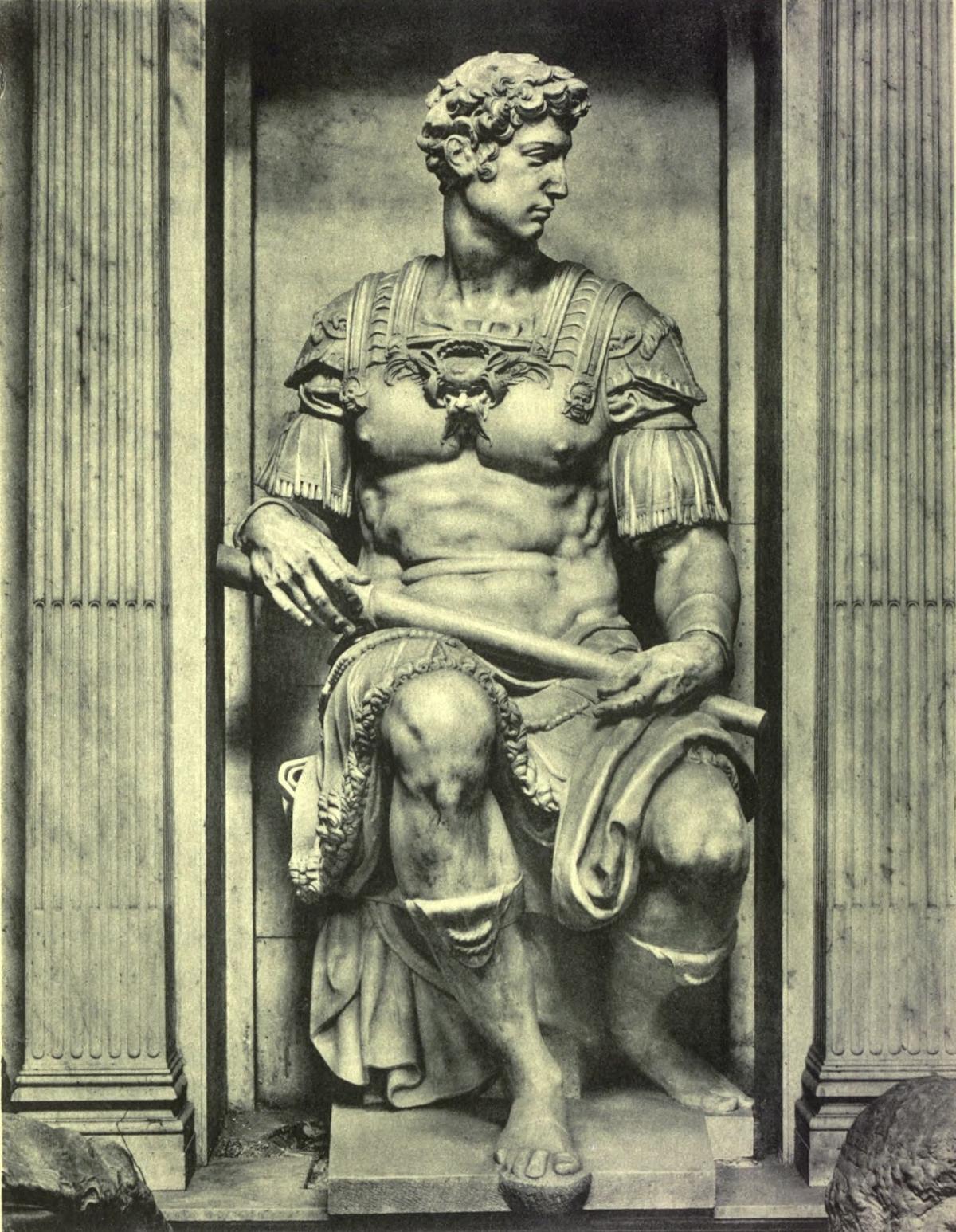
At this time he sent his disciple Pietro Urbano of Pistoia to Rome to carry to completion a nude Christ holding the Cross, a most admirable figure, which was placed beside the principal chapel of the Minerva, at the commission of Messer Antonio Metelli. About the same time there took place the sack of Rome and the expulsion of the Medici from Florence; by reason of which upheaval those who governed the city of Florence resolved to rebuild the fortifications, and therefore made Michelangelo Commissary General over all that work. Whereupon he made designs and caused fortifications to be built for several parts of the city, and finally encircled the hill of San Miniato with bastions, which he made not with sods of earth, wood, and bundles of brushwood, as is generally done, but with a stout base of chestnut, oak, and other good materials interwoven, and in place of sods he took unbaked bricks made with tow and the dung of cattle, squared with very great diligence. And for this reason he was sent by the Signoria of Florence to Ferrara, to inspect the fortifications of Duke Alfonso I, and so also his artillery and munitions; where he received many courtesies from that lord, who besought him that he should do something for him with his own hand at his leisure, and Michelangelo promised that he would. After his return, he was continually engaged in fortifying the city, but, although he was thus occupied, nevertheless he kept working at a picture of a Leda for that Duke, painted with his own hand in distemper-colours, which was a divine thing, as will be related in the proper place; also continuing the statues for the tombs of S. Lorenzo, but in secret. At this time Michelangelo spent some six months on the hill of San Miniato in order to press on the fortification of that hill, because if the enemy became master of it, the city was lost; and so he pursued these undertakings with the utmost diligence.
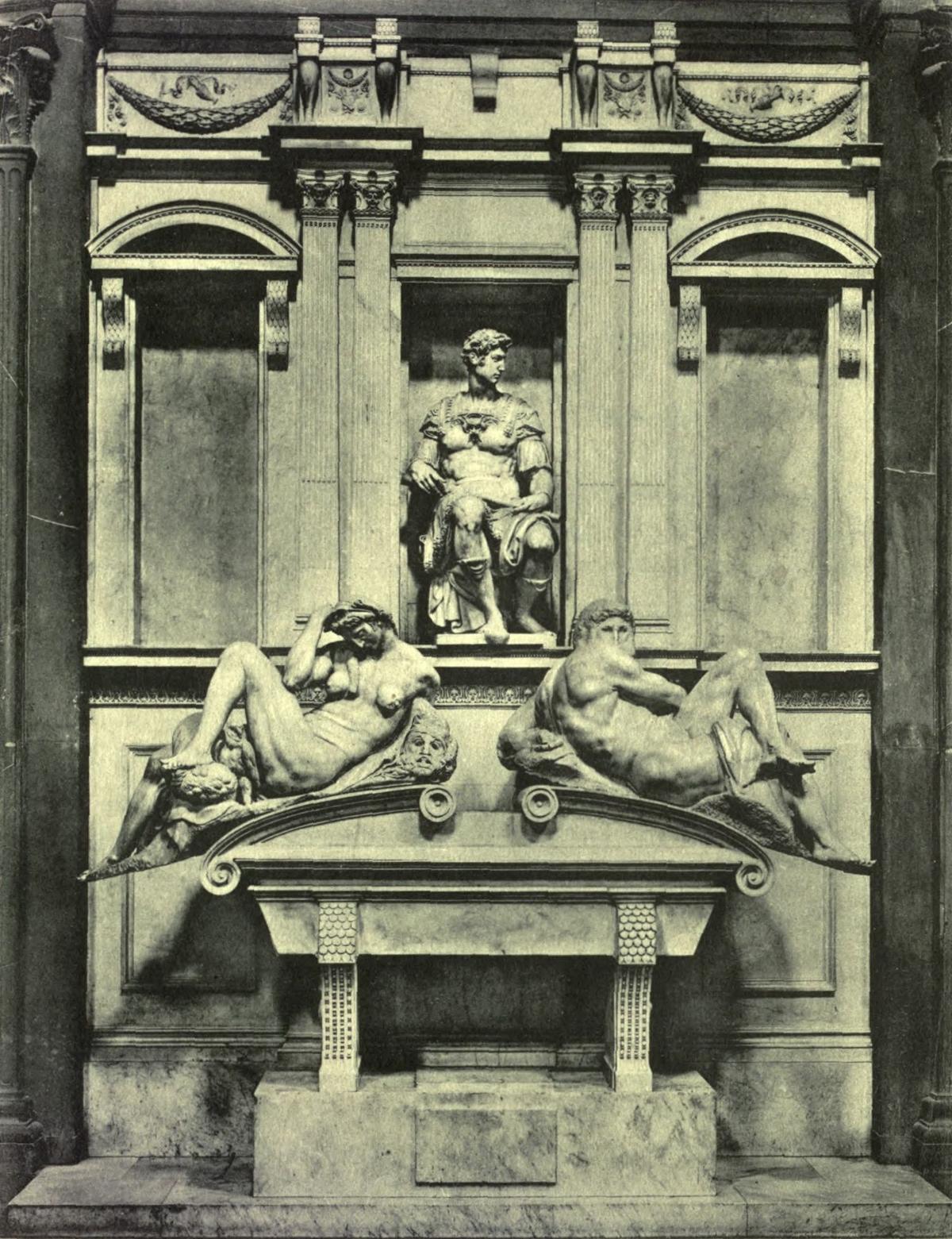
At this same time he continued the work in the above-mentioned sacristy, in which were seven statues that were left partly finished and partly not. With these, and with the architectural inventions of the tombs, it must be confessed that he surpassed every man in these three professions; to which testimony is borne by the statues of marble, blocked out and finished by him, which are to be seen in that place. One is Our Lady, who is in a sitting attitude, with the right leg crossed over the left and one knee placed upon the other, and the Child, with the thighs astride the leg that is uppermost, turns in a most beautiful attitude towards His Mother, hungry for her milk, and she, while holding Him with one hand and supporting herself with the other, bends forward to give it to Him; and although the figure is not equal in every part, and it was left rough and showing the marks of the gradine, yet with all its imperfections there may be recognized in it the full perfection of the work. Even more did he cause everyone to marvel by the circumstance that in making the tombs of Duke Giuliano and Duke Lorenzo de' Medici he considered that earth alone was not enough to give them honourable burial in their greatness, and desired that all the phases of the world should be there, and that their sepulchres should be surrounded and covered by four statues; wherefore he gave to one Night and Day, and to the other Dawn and Twilight; which statues, most beautifully wrought in form, in attitude, and in the masterly treatment of the muscles, would suffice, if that art were lost, to restore her to her pristine lustre. There, among the other statues, are the two Captains, armed; one the pensive Duke Lorenzo, the very presentment of wisdom, with legs so beautiful and so well wrought, that there is nothing better to be seen by mortal eye; and the other is Duke Giuliano, so proud a figure, with the head, the throat, the setting of the eyes, the profile of the nose, the opening of the mouth, and the hair all so divine, to say nothing of the hands, arms, knees, feet, and, in short, every other thing that he carved therein, that the eye can never be weary or have its fill of gazing at them; and, of a truth, whoever studies the beauty of the buskins and the cuirass, believes it to be celestial rather than mortal. But what shall I say of the Dawn, a nude woman, who is such as to awaken melancholy in the soul and to render impotent the style of sculpture? In her attitude may be seen her effort, as she rises, heavy with sleep, and raises herself from her downy bed; and it seems that in awakening she has found the eyes of that great Duke closed in death, so that she is agonized with bitter grief, weeping in her own unchangeable beauty in token of her great sorrow. And what can I say of the Night, a statue not rare only, but unique? Who is there who has ever seen in that art in any age, ancient or modern, statues of such a kind? For in her may be seen not only the stillness of one sleeping, but the grief and melancholy of one who has lost a great and honoured possession; and we must believe that this is that night of darkness that obscures all those who thought for some time, I will not say to surpass, but to equal Michelangelo in sculpture and design. In that statue is infused all the somnolence that is seen in sleeping forms; wherefore many verses in Latin and rhymes in the vulgar tongue were written in her praise by persons of great learning, such as these, of which the author is not known—
La Notte che tu vedi in si dolci atti Dormire, fu da un Angelo scolpita In questo sasso; e perche dorme, ha vita. Destala, se no ‘l credi, e parleratti.
To which Michelangelo , speaking in the person of Night, answered thus—
Grato mi è il sonno, e più l‘esser di sasso; Mentre che il danno e la vergogna dura, Non veder’ non sentir‘ m’è gran ventura. Però non mi destar'; deh parla basso.
Truly, if the enmity that there is between Fortune and Genius, between the envy of the one and the excellence of the other, had not prevented such a work from being carried to completion, Art was like to prove to Nature that she surpassed her by a great measure in every conception.
While Michelangelo was labouring with the greatest solicitude and love at these works, there came in 1529 the siege of Florence, which hindered their completion only too effectually, and was the reason that he did little or no more work upon them, the citizens having laid upon him the charge of fortifying not only the hill of S. Miniato, but also the city, as we have related. And thus, having lent a thousand crowns to that Republic, and being elected one of the Nine, a military Council appointed for the war, he turned all his mind and soul to perfecting those fortifications. But in the end, when the enemy had closed round the city, and all hope of assistance was failing little by little, and the difficulties of maintaining the defence were increasing, and it appeared to Michelangelo that he was in a sorry pass with regard to his personal safety, he determined to leave Florence and make his way to Venice, without making himself known to anyone on the road. He set out secretly, therefore, by way of the hill of S. Miniato, without anyone knowing of it, taking with him Antonio Mini, his disciple, and the goldsmith Piloto, his faithful friend; and each of them carried a number of crowns on his person, sewn into his quilted doublet. Having arrived in Ferrara, they rested there; and it happened that on account of the alarm caused by the war and the league of the Emperor and the Pope, who were besieging Florence, Duke Alfonso d'Este was keeping strict watch in Ferrara, and required to be secretly informed by the hosts who gave lodging to travellers of the names of all those who lodged with them from one day to another; and he caused a list of all foreigners, with their nationality, to be brought to him every day. It came to pass, then, that when Michelangelo had dismounted with his companions, intending to stay there without revealing himself, this became known in that way to the Duke, who was very glad, because he had already become his friend. That Prince was a man of lofty mind, delighting constantly in persons of ability all his life long, and he straightway sent some of the first men of his Court with orders to conduct him in the name of his Excellency to the Palace, where the Duke was, to remove thither his horses and all his baggage, and to give him a handsome lodging in that Palace. Michelangelo , finding himself in the power of another, was constrained to obey and to make the best of a bad business, and he went with those courtiers to the Duke, but without removing his baggage from the inn. Thereupon the Duke, after first complaining of his reserve, gave him a great reception; and then, making him rich and honourable presents, he sought to detain him in Ferrara with the promise of a fine salary. He, having his mind set on something else, would not consent to remain; but the Duke again made him a free offer of all that was in his power, praying him that he should at least not depart as long as the war continued. Whereupon Michelangelo , not wishing to be outdone in courtesy, thanked him warmly, and, turning towards his two companions, said that he had brought twelve thousand crowns to Ferrara, and that, if the Duke had need of them, they were at his disposal, together with himself. The Duke then took him through the Palace to divert him, as he had done on another occasion, and showed him all the beautiful things that he had there, including a portrait of himself by Tiziano, which was much commended by Michelangelo . However, his Excellency was not able to keep him in the Palace, for he insisted on returning to the inn; wherefore the host who was lodging him received from the Duke a great abundance of things wherewith to do him honour, and also orders that at his departure he should not accept anything for his lodging. From Ferrara he made his way to Venice, where many gentlemen sought to become known to him; but he, who always had a very poor opinion of their knowledge of his profession, departed from the Giudecca, where he had his lodging. There, so it is said, he made for that city at that time, at the request of the Doge Gritti, a design for the bridge of the Rialto, which was very rare in invention and in ornamentation.
Michelangelo was invited with great insistence to go back to his native country, being urgently requested not to abandon his undertaking there, and receiving a safe-conduct; and finally, vanquished by love of her, he returned, but not without danger to his life. At this time he finished the Leda that he was painting, as has been related, at the request of Duke Alfonso; and it was afterwards taken to France by Antonio Mini, his disciple. And at this same time he saved the campanile of S. Miniato, a tower which sorely harassed the enemy’s forces with its two pieces of artillery, so that their artillerists, having set to work to batter it with heavy cannon, had half ruined it, and were like to destroy it completely, when Michelangelo protected it so well with bales of wool and stout mattresses suspended by cords, that it is still standing. It is said, also, that at the time of the siege there came to him an opportunity to acquire, according to a desire that he had long had, a block of marble of nine braccia which had come from Carrara, and which Pope Clement, after much rivalry and contention between him and Baccio Bandinelli, had given to Baccio. But Michelangelo , now that such a matter was in the hands of the Commonwealth, asked for it from the Gonfalonier, who gave it to him that he might likewise try his hand upon it, although Baccio had already made a model and hacked away much of the stone in blocking it out. Thereupon Michelangelo made a model, which was held to be a marvellous and very beautiful thing; but on the return of the Medici the marble was restored to Baccio.
When peace had been made, Baccio Valori, the Pope’s Commissioner, received orders to have some of the most partisan citizens arrested and imprisoned in the Bargello, and the same tribunal sought out Michelangelo at his house; but he, fearing that, had fled secretly to the house of one who was much his friend, where he remained hidden many days. Finally, when the first fury had abated, Pope Clement, remembering the ability of Michelangelo , caused a diligent search to be made for him, with orders that nothing should be said to him, but rather that his former appointments should be restored to him, and that he should attend to the work of S. Lorenzo, over which he placed as proveditor M. Giovan Battista Figiovanni, the old servant of the Medici family and Prior of S. Lorenzo. Thus reassured, Michelangelo , in order to make Baccio Valori his friend, began a figure of three braccia in marble, which was an Apollo drawing an arrow from his quiver, and carried it almost to completion. It is now in the apartment of the Prince of Florence, and is a very rare work, although it is not completely finished.
At this time a certain gentleman was sent to Michelangelo by Duke Alfonso of Ferrara, who, having heard that the master had made some rare work for him with his own hand, did not wish to lose such a jewel. Having arrived in Florence and found Michelangelo , the envoy presented to him letters of recommendation from that lord; whereupon Michelangelo , receiving him courteously, showed him the Leda embracing the Swan that he had painted, with Castor and Pollux issuing from the Egg, in a large picture executed in distemper, as it were with the breath. The Duke’s envoy, thinking from the praise that he heard everywhere of Michelangelo that he should have done something great, and not recognizing the excellence and artistry of that figure, said to Michelangelo : “Oh, this is but a trifle.” Michelangelo , knowing that no one is better able to pronounce judgment on works than those who have had long practise in them, asked him what was his vocation. And he answered, with a sneer, “I am a merchant”; believing that he had not been recognized by Michelangelo as a gentleman, and as it were making fun of such a question, and at the same time affecting to despise the industry of the Florentines. Michelangelo , who had understood perfectly the meaning of his words, at once replied: “You will find you have made a bad bargain this time for your master. Get you gone out of my sight.”
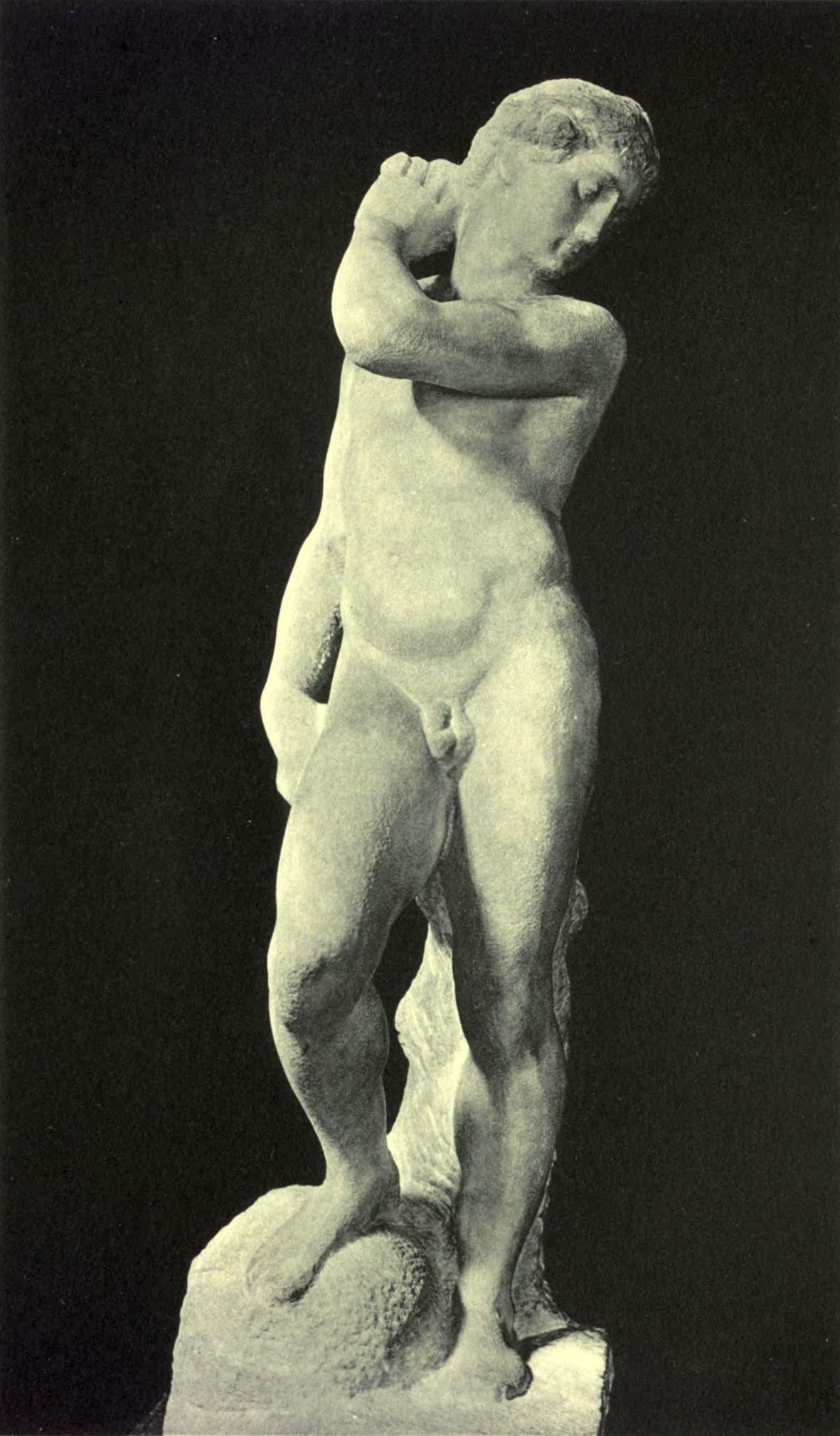
Now in those days Antonio Mini, his disciple, who had two sisters waiting to be married, asked him for the Leda, and he gave it to him willingly, with the greater part of the designs and cartoons that he had made, which were divine things, and also two chests full of models, with a great number of finished cartoons for making pictures, and some of works that had been painted. When Antonio took it into his head to go to France, he carried all these with him; the Leda he sold to King Francis by means of some merchants, and it is now at Fontainebleau, but the cartoons and designs were lost, for he died there in a short time, and some were stolen; and so our country was deprived of all these valuable labours, which was an incalculable loss. The cartoon of the Leda has since come back to Florence, and Bernardo Vecchietti has it; and so also four pieces of the cartoons for the chapel, with nudes and Prophets, brought back by the sculptor Benvenuto Cellini, and now in the possession of the heirs of Girolamo degli Albizzi.
It became necessary for Michelangelo to go to Rome to see Pope Clement, who, although angry with him, yet, as the friend of every talent, forgave him everything, and gave him orders that he should return to Florence and have the library and sacristy of S. Lorenzo completely finished; and, in order to shorten that work, a vast number of statues that were to be included in it were distributed among other masters. Two he allotted to Tribolo, one to Raffaello da Montelupo, and one to Fra Giovanni Agnolo, the Servite friar, all sculptors; and he gave them assistance in these, making rough models in clay for each of them. Whereupon they all worked valiantly, and he, also, caused work to be pursued on the library, and thus the ceiling was finished in carved woodwork, which was executed after his models by the hands of the Florentines Carota and Tasso, excellent carvers and also masters of carpentry; and likewise the shelves for the books, which were executed at that time by Battista del Cinque and his friend Ciappino, good masters in that profession. And in order to give the work its final perfection there was summoned to Florence the divine Giovanni da Udine, who, together with others his assistants and also some Florentine masters, decorated the tribune with stucco; and they all sought with great solicitude to give completion to that vast undertaking.
Now, just as Michelangelo was about to have the statues carried into execution, at that very time the Pope took it into his head to have him near his person, being desirous to have the walls of the Chapel of Sixtus painted, where Michelangelo had painted the vaulting for Julius II, his nephew. On the principal wall, where the altar is, Clement wished him to paint the Universal Judgment, to the end that he might display in that scene all that the art of design could achieve, and opposite to it, on the other wall, over the principal door, he had commanded that he should depict the scene when Lucifer was expelled for his pride from Heaven, and all those Angels who sinned with him were hurled after him into the centre of Hell: of which inventions it was found that Michelangelo many years before had made various sketches and designs, one of which was afterwards carried into execution in the Church of the Trinità at Rome by a Sicilian painter, who stayed many months with Michelangelo , to serve him and to grind his colours. This work, painted in fresco, is in the Chapel of S. Gregorio, in the cross of the church, and, although it is executed badly, there is a certain variety and terrible force in the attitudes and groups of those nudes that are raining down from Heaven, and of the others who, having fallen into the centre of the earth, are changed into various forms of Devils, very horrible and bizarre; and it is certainly an extraordinary fantasy. While Michelangelo was directing the preparation of the designs and cartoons of the Last Judgment on the first wall, he never ceased for a single day to be at strife with the agents of the Duke of Urbino, by whom he was accused of having received sixteen thousand crowns from Julius II for the tomb. This accusation was more than he could bear, and he desired to finish the work some day, although he was already an old man, and he would have willingly stayed in Rome to finish it, now that he had found, without seeking it, such a pretext for not returning any more to Florence, since he had a great fear of Duke Alessandro de' Medici, whom he regarded as little his friend; for, when the Duke had given him to understand through Signor Alessandro Vitelli that he should select the best site for the building of the castle and citadel of Florence, he answered that he would not go save at the command of Pope Clement.
Finally an agreement was formed in the matter of the tomb, that it should be finished in the following manner: there was no longer to be an isolated tomb in a rectangular shape, but only one of the original façades, in the manner that best pleased Michelangelo , and he was to be obliged to place in it six statues by his own hand. In this contract that was made with the Duke of Urbino, his Excellency consented that Michelangelo should be at the disposal of Pope Clement for four months in the year, either in Florence or wherever he might think fit to employ him. But, although it seemed to Michelangelo that at last he had obtained some peace, he was not to be quit of it so easily, for Pope Clement, desiring to see the final proof of the force of his art, kept him occupied with the cartoon of the Judgment. However, contriving to convince the Pope that he was thus engaged, at the same time he kept working in secret, never relaxing his efforts, at the statues that were going into the above-named tomb.
In the year 1533[1] came the death of Pope Clement, whereupon the work of the library and sacristy in Florence, which had remained unfinished in spite of all the efforts made to finish it, was stopped. Then, at length, Michelangelo thought to be truly free and able to give his attention to finishing the tomb of Julius II. But Paul III, not long after his election, had him summoned to his presence, and, besides paying him compliments and making him offers, requested him to enter his service and remain near his person. Michelangelo refused, saying that he was not able to do it, being bound by contract to the Duke of Urbino until the tomb of Julius should be finished. The Pope flew into a rage and said: “I have had this desire for thirty years, and now that I am Pope do you think I shall not satisfy it? I shall tear up the contract, for I am determined to have you serve me, come what may.” Michelangelo , hearing this resolution, was tempted to leave Rome and in some way find means to give completion to the tomb; however, fearing, like a wise man, the power of the Pope, he resolved to try to keep him pacified with words, seeing that he was so old, until something should happen. The Pope, who wished to have some extraordinary work executed by Michelangelo , went one day with ten Cardinals to visit him at his house, where he demanded to see all the statues for the tomb of Julius, which appeared to him marvellous, and particularly the Moses, which figure alone was said by the Cardinal of Mantua to be enough to do honour to Pope Julius. And after seeing the designs and cartoons that he was preparing for the wall of the chapel, which appeared to the Pope to be stupendous, he again besought Michelangelo with great insistence that he should enter his service, promising that he would persuade the Duke of Urbino to content himself with three statues, and that the others should be given to other excellent masters to execute after his models. Whereupon, his Holiness having arranged this with the agents of the Duke, a new contract was made, which was confirmed by the Duke; and Michelangelo of his own free will bound himself to pay for the other three statues and to have the tomb erected, depositing for this purpose in the bank of the Strozzi one thousand five hundred and eighty ducats. This he might have avoided, and it seemed to him that he had truly done enough to be free of such a long and troublesome undertaking; and afterwards he caused the tomb to be erected in S. Pietro in Vincola in the following manner. He erected the lower base, which was all carved, with four pedestals which projected outwards as much as was necessary to give space for the captive that was originally intended to stand on each of them, instead of which there was left a terminal figure; and since the lower part had thus a poor effect, he placed at the feet of each terminal figure a reversed console resting on the pedestal. Those four terminal figures had between them three niches, two of which (those at the sides) were round, and were to have contained the Victories. Instead of the Victories, he placed in one Leah, the daughter of Laban, to represent the Active Life, with a mirror in her hand to signify the consideration that we should give to our actions, and in the other hand a garland of flowers, to denote the virtues that adorn our life during its duration, and make it glorious after death; and the other figure was her sister Rachel, representing the Contemplative Life, with the hands clasped and one knee bent, and on the countenance a look as of ecstasy of spirit. These statues Michelangelo executed with his own hand in less than a year. In the centre is the other niche, rectangular in shape, which in the original design was to have been one of the doors that were to lead into the little oval temple of the rectangular tomb; this having become a niche, there is placed in it, upon a dado of marble, the gigantic and most beautiful statue of Moses, of which we have already said enough. Above the heads of the terminal figures, which form capitals, are architrave, frieze, and cornice, which project beyond those figures and are carved with rich ornaments, foliage, ovoli, dentils, and other rich members, distributed over the whole work. Over that cornice rises another course, smooth and without carvings, but with different terminal figures standing directly above those below, after the manner of pilasters, with a variety of cornice-members; and since this course accompanies that below and resembles it in every part, there is in it a space similar to the other, forming a niche like that in which there is now the Moses, and in the niche, resting on projections of the cornice, is a sarcophagus of marble with the recumbent statue of Pope Julius, executed by the sculptor Maso dal Bosco, while in that niche, also, there stands a Madonna who is holding her Son in her arms, wrought by the sculptor Scherano da Settignano from a model by Michelangelo ; which statues are passing good. In two other rectangular niches, above the Active and the Contemplative Life, are two larger statues, a Prophet and a Sibyl seated, which were both executed by Raffaello da Montelupo, as has been related in the Life of his father Baccio, but little to the satisfaction of Michelangelo . For its crowning completion this work had a different cornice, which, like those below, projected over the whole work; and above the terminal figures, as a finish, were candelabra of marble, with the arms of Pope Julius in the centre. Above the Prophet and the Sibyl, in the recess of each niche, he made a window for the convenience of the friars who officiate in that church, the choir having been made behind; which windows serve to send their voices into the church when they say the divine office, and permit the celebration to be seen. Truly this whole work has turned out very well, but not by a great measure as it had been planned in the original design.
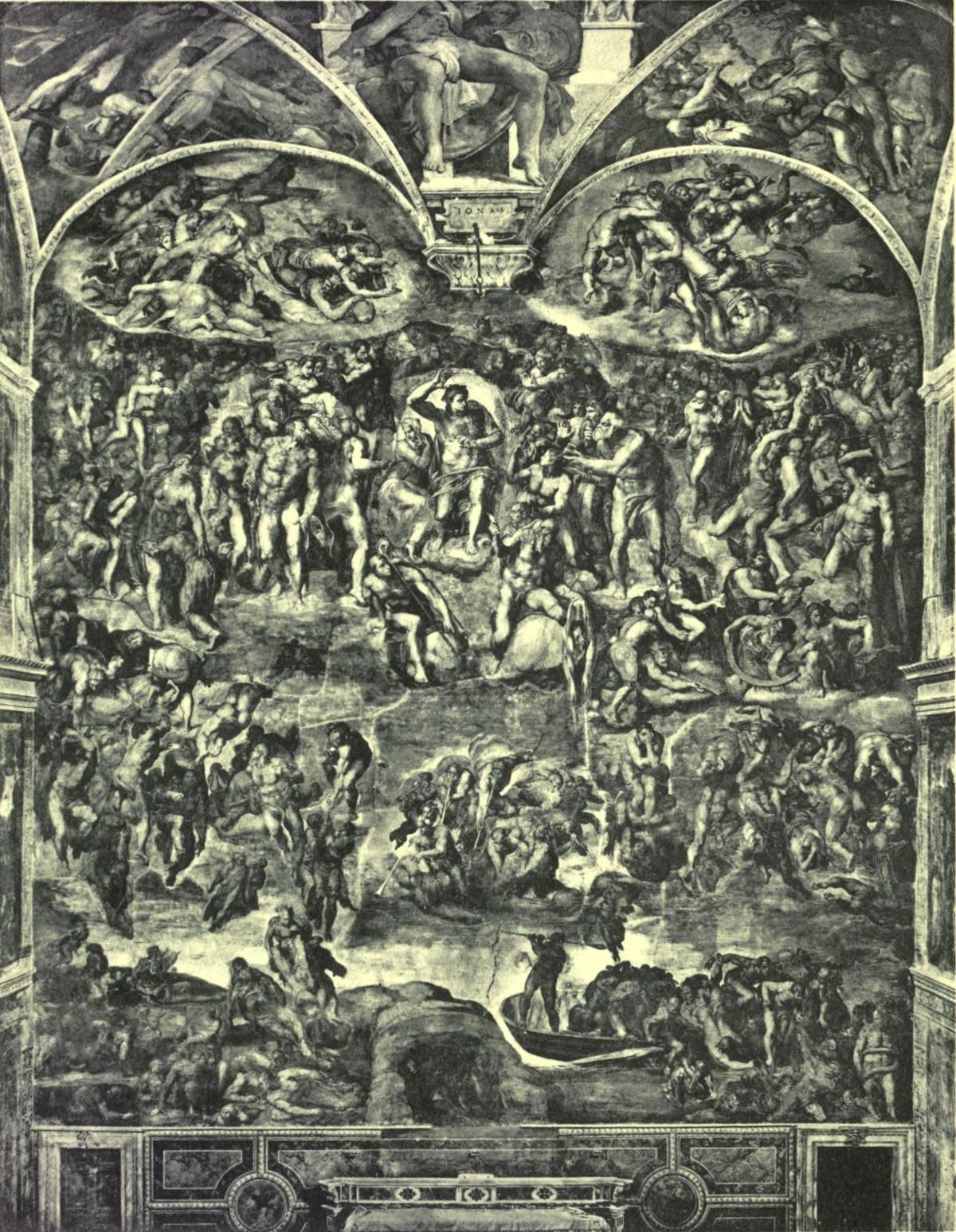
(After the fresco by Michelangelo . Rome: The Vatican, Sistine Chapel) Anderson
Michelangelo resolved, since he could not do otherwise, to serve Pope Paul, who allowed him to continue the work as ordered by Clement, without changing anything in the inventions and the general conception that had been laid before him, thus showing respect for the genius of that great man, for whom he felt such reverence and love that he sought to do nothing but what pleased him; of which a proof was soon seen. His Holiness desired to place his own arms beneath the Jonas in the chapel, where those of Pope Julius II had previously been put; but Michelangelo , being asked to do this, and not wishing to do a wrong to Julius and Clement, would not place them there, saying that they would not look well; and the Pope, in order not to displease him, was content to have it so, having recognized very well the excellence of such a man, and how he always followed what was just and honourable without any adulation or respect of persons—a thing that the great are wont to experience very seldom. Michelangelo , then, caused a projection of well baked and chosen bricks to be carefully built on the wall of the above-named chapel (a thing which was not there before), and contrived that it should overhang half a braccio from above, so that neither dust nor any other dirt might be able to settle upon it. But I will not go into the particulars of the invention and composition of this scene, because so many copies of it, both large and small, have been printed, that it does not seem necessary to lose time in describing it. It is enough for us to perceive that the intention of this extraordinary man has been to refuse to paint anything but the human body in its best proportioned and most perfect forms and in the greatest variety of attitudes, and not this only, but likewise the play of the passions and contentments of the soul, being satisfied with justifying himself in that field in which he was superior to all his fellow-craftsmen, and to lay open the way of the grand manner in the painting of nudes, and his great knowledge in the difficulties of design; and, finally, he opened out the way to facility in this art in its principal province, which is the human body, and, attending to this single object, he left on one side the charms of colouring and the caprices and new fantasies of certain minute and delicate refinements which many other painters, perhaps not without some show of reason, have not entirely neglected. For some, not so well grounded in design, have sought with variety of tints and shades of colouring, with various new and bizarre inventions, and, in short, with the other method, to win themselves a place among the first masters; but Michelangelo , standing always firmly rooted in his profound knowledge of art, has shown to those who know enough how they should attain to perfection.
But to return to the story: Michelangelo had already carried to completion more than three-fourths of the work, when Pope Paul went to see it. And Messer Biagio da Cesena, the master of ceremonies, a person of great propriety, who was in the chapel with the Pope, being asked what he thought of it, said that it was a very disgraceful thing to have made in so honourable a place all those nude figures showing their nakedness so shamelessly, and that it was a work not for the chapel of a Pope, but for a bagnio or tavern. Michelangelo was displeased at this, and, wishing to revenge himself, as soon as Biagio had departed he portrayed him from life, without having him before his eyes at all, in the figure of Minos with a great serpent twisted round the legs, among a heap of Devils in Hell; nor was Messer Biagio’s pleading with the Pope and with Michelangelo to have it removed of any avail, for it was left there in memory of the occasion, and it is still to be seen at the present day.
It happened at this time that Michelangelo fell no small distance from the staging of this work, and hurt his leg; and in his pain and anger he would not be treated by anyone. Now there was living at this same time the Florentine Maestro Baccio Rontini, his friend, an ingenious physician, who had a great affection for his genius; and he, taking compassion on him, went one day to knock at his door. Receiving no answer either from the neighbours or from him, he so contrived to climb by certain secret ways from one room to another, that he came to Michelangelo , who was in a desperate state. And then Maestro Biagio would never abandon him or take himself off until he was cured.
Having recovered from this injury, he returned to his labour, and, working at it continually, he carried it to perfect completion in a few months, giving such force to the paintings in the work, that he justified the words of Dante—
Morti li morti, i vivi parean vivi.
And here, also, may be seen the misery of the damned and the joy of the blessed. Wherefore, when this Judgment was thrown open to view, it proved that he had not only vanquished all the earlier masters who had worked there, but had sought to surpass the vaulting that he himself had made so famous, excelling it by a great measure and outstripping his own self. For he imagined to himself the terror of those days, and depicted, for the greater pain of all who have not lived well, the whole Passion of Christ, causing various naked figures in the air to carry the Cross, the Column, the Lance, the Sponge, the Nails, and the Crown of Thorns, all in different attitudes, executed to perfection in a triumph of facility over their difficulties. In that scene is Christ seated, with a countenance proud and terrible, turning towards the damned and cursing them; not without great fear in Our Lady, who, hearing and beholding that vast havoc, draws her mantle close around her. There are innumerable figures, Prophets and Apostles, that form a circle about Him, and in particular Adam and S. Peter, who are believed to have been placed there, one as the first parent of those thus brought to judgment, and the other as having been the first foundation of the Christian Church; and at His feet is a most beautiful S. Bartholomew, who is displaying his flayed skin. There is likewise a nude figure of S. Laurence; besides which, there are multitudes of Saints without number, both male and female, and other figures, men and women, around Him, near or distant, who embrace one another and make rejoicing, having received eternal blessedness by the grace of God and as the reward of their works. Beneath the feet of Christ are the Seven Angels with the Seven Trumpets described by S. John the Evangelist, who, as they sound the call to judgment, cause the hair of all who behold them to stand on end at the terrible wrath that their countenances reveal. Among others are two Angels that have each the Book of Life in the hands: and near them, on one side, not without beautiful consideration, are seen the Seven Mortal Sins in the forms of Devils, assailing and striving to drag down to Hell the souls that are flying towards Heaven, all with very beautiful attitudes and most admirable foreshortenings. Nor did he hesitate to show to the world, in the resurrection of the dead, how they take to themselves flesh and bones once more from the same earth, and how, assisted by others already alive, they go soaring towards Heaven, whence succour is brought to them by certain souls already blessed; not without evidence of all those marks of consideration that could be thought to be required in so great a work. For studies and labours of every kind were executed by him, which may be recognized throughout the whole work without exception; and this is manifested with particular clearness in the barque of Charon, who, in an attitude of fury, strikes with his oars at the souls dragged down by the Devils into the barque, after the likeness of the picture that the master’s best-beloved poet, Dante, described when he said—
Caron demonio con occhi di bragia, Loro accennando, tutte le raccoglie, Batte col remo qualunque si adagia.
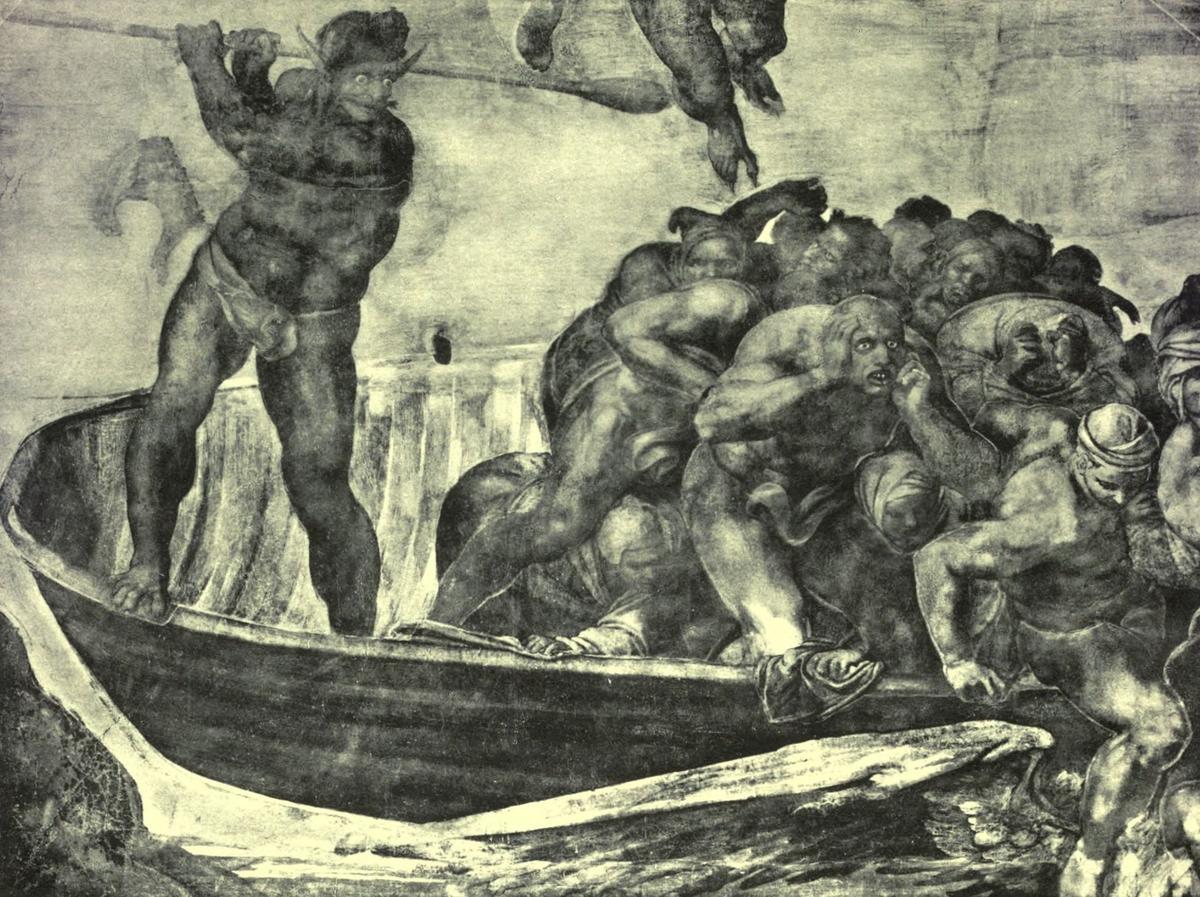
Nor would it be possible to imagine how much variety there is in the heads of those Devils, which are truly monsters from Hell. In the sinners may be seen sin and the fear of eternal damnation; and, to say nothing of the beauty of every detail, it is extraordinary to see so great a work executed with such harmony of painting, that it appears as if done in one day, and with such finish as was never achieved in any miniature. And, of a truth, the terrible force and grandeur of the work, with the multitude of figures, are such that it is not possible to describe it, for it is filled with all the passions known to human creatures, and all expressed in the most marvellous manner. For the proud, the envious, the avaricious, the wanton, and all the other suchlike sinners can be distinguished with ease by any man of fine perception, because in figuring them Michelangelo observed every rule of Nature in the expressions, in the attitudes, and in every other natural circumstance; a thing which, although great and marvellous, was not impossible to such a man, for the reason that he was always observant and shrewd and had seen men in plenty, and had acquired by commerce with the world that knowledge that philosophers gain from cogitation and from writings. Wherefore he who has judgment and understanding in painting perceives there the most terrible force of art, and sees in those figures such thoughts and passions as were never painted by any other but Michelangelo . So, also, he may see there how the variety of innumerable attitudes is accomplished, in the strange and diverse gestures of young and old, male and female; and who is there who does not recognize in these the terrible power of his art, together with the grace that he had from Nature, since they move the hearts not only of those who have knowledge in that profession, but even of those who have none? There are foreshortenings that appear as if in relief, a harmony of painting that gives great softness, and fineness in the parts painted by him with delicacy, all showing in truth how pictures executed by good and true painters should be; and in the outlines of the forms turned by him in such a way as could not have been achieved by any other but Michelangelo , may be seen the true Judgment and the true Damnation and Resurrection. This is for our art the exemplar and the grand manner of painting sent down to men on earth by God, to the end that they may see how Destiny works when intellects descend from the heights of Heaven to earth, and have infused in them divine grace and knowledge. This work leads after it bound in chains those who persuade themselves that they have mastered art; and at the sight of the strokes drawn by him in the outlines of no matter what figure, every sublime spirit, however mighty in design, trembles and is afraid. And while the eyes gaze at his labours in this work, the senses are numbed at the mere thought of what manner of things all other pictures, those painted and those still unpainted, would appear if placed in comparison with such perfection. Truly blessed may he be called, and blessed his memories, who has seen this truly stupendous marvel of our age! Most happy and most fortunate Paul III, in that God granted that under thy protection should be acquired the renown that the pens of writers shall give to his memory and thine! How highly are thy merits enhanced by his genius! And what good fortune have the craftsmen had in this age from his birth, in that they have seen the veil of every difficulty torn away, and have beheld in the pictures, sculptures, and architectural works executed by him all that can be imagined and achieved!
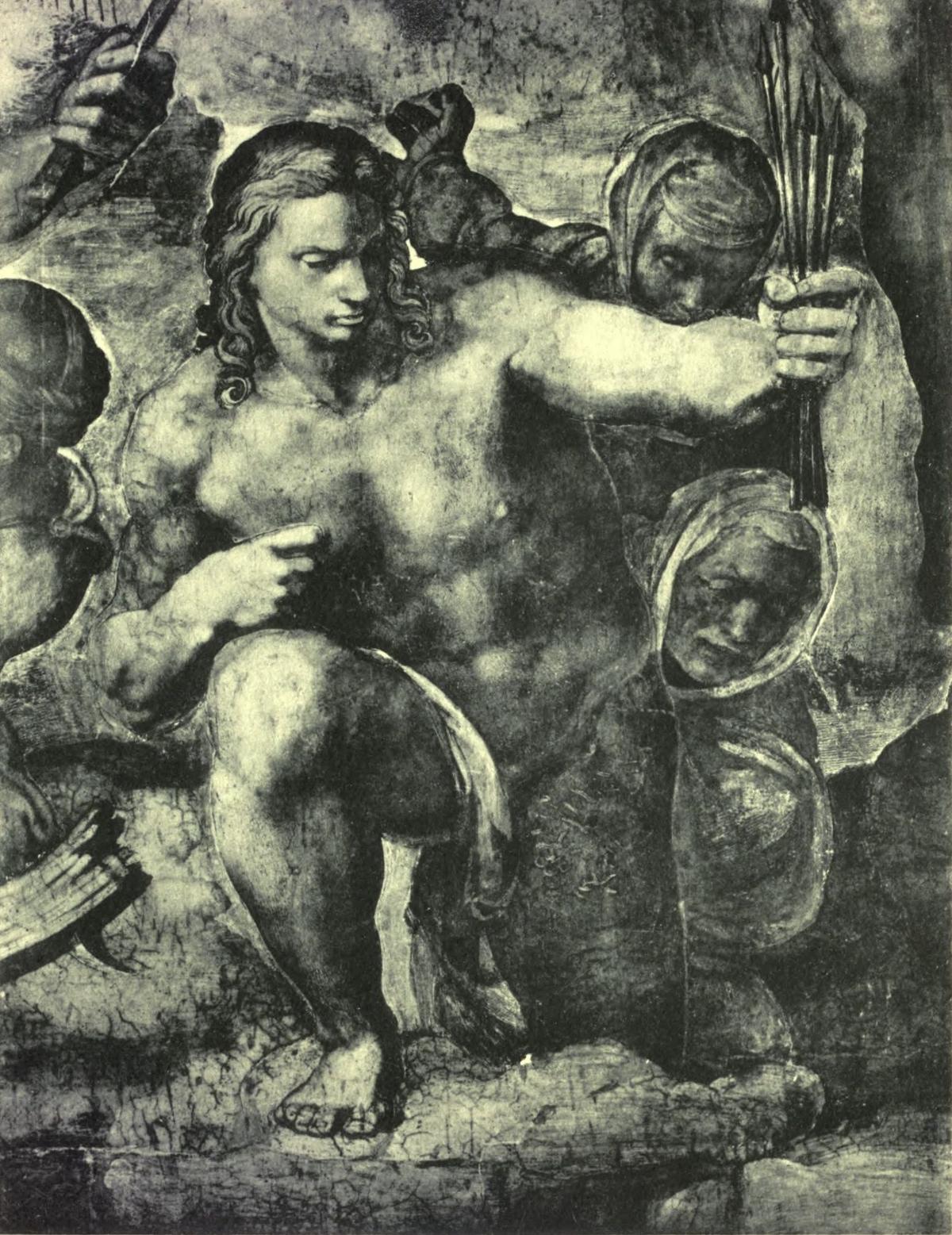
He toiled eight years over executing this work, and threw it open to view in the year 1541, I believe, on Christmas day, to the marvel and amazement of all Rome, nay, of the whole world; and I, who was that year in Venice, and went to Rome to see it, was struck dumb by its beauty.
Pope Paul, as has been related, had caused a chapel called the Pauline to be erected on the same floor by Antonio da San Gallo, in imitation of that of Nicholas V; and in this he resolved that Michelangelo should paint two great pictures with two large scenes. In one he painted the Conversion of S. Paul, with Jesus Christ in the air and a multitude of nude Angels making most beautiful movements, and below, all dazed and terrified, Paul fallen from his horse to the level of the ground, with his soldiers about him, some striving to raise him up, and others, struck with awe by the voice and splendour of Christ, are flying in beautiful attitudes and marvellous movements of panic, while the horse, taking to flight, appears to be carrying away in its headlong course him who seeks to hold it back; and this whole scene is executed with extraordinary design and art. In the other picture is the Crucifixion of S. Peter, who is fixed, a nude figure of rare beauty, upon the cross; showing the ministers of the crucifixion, after they have made a hole in the ground, seeking to raise the cross on high, to the end that he may remain crucified with his feet in the air; and there are many remarkable and beautiful considerations. Michelangelo , as has been said elsewhere, gave his attention only to the perfection of art, and therefore there are no landscapes to be seen there, nor trees, nor buildings, nor any other distracting graces of art, for to these he never applied himself, as one, perchance, who would not abase his great genius to such things. These, executed by him at the age of seventy-five, were his last pictures, and, as he used himself to tell me, they cost him much fatigue, for the reason that painting, and particularly working in fresco, is no art for men who have passed a certain age. Michelangelo arranged that Perino del Vaga, a very excellent painter, should decorate the vaulting with stucco and with many things in painting, after his designs, and such, also, was the wish of Pope Paul III; but the work was afterwards delayed, and nothing more was done, even as many undertakings are left unfinished, partly by the fault of want of resolution in the craftsmen, and partly by that of Princes little zealous in urging them on.
Pope Paul had made a beginning with the fortifying of the Borgo, and had summoned many gentlemen, together with Antonio da San Gallo, to a conference; but he wished that Michelangelo also should have a part in this, knowing that the fortifications about the hill of S. Miniato in Florence had been constructed under his direction. After much discussion, Michelangelo was asked what he thought; and he, having opinions contrary to San Gallo and many others, declared them freely. Whereupon San Gallo said to him that his arts were sculpture and painting, and not fortification. Michelangelo replied that of sculpture and painting he knew little, but of fortification, what with the thought that he had devoted to it for a long time, and his experience in what he had done, it appeared to him that he knew more than either Antonio or any of his family; showing him in the presence of the company that he had made many errors in that art. Words rising high on either side, the Pope had to command silence; but no long time passed before Michelangelo brought a design for all the fortifications of the Borgo, which laid open the way for all that has since been ordained and executed; and this was the reason that the great gate of S. Spirito, which was approaching completion under the direction of San Gallo, was left unfinished.
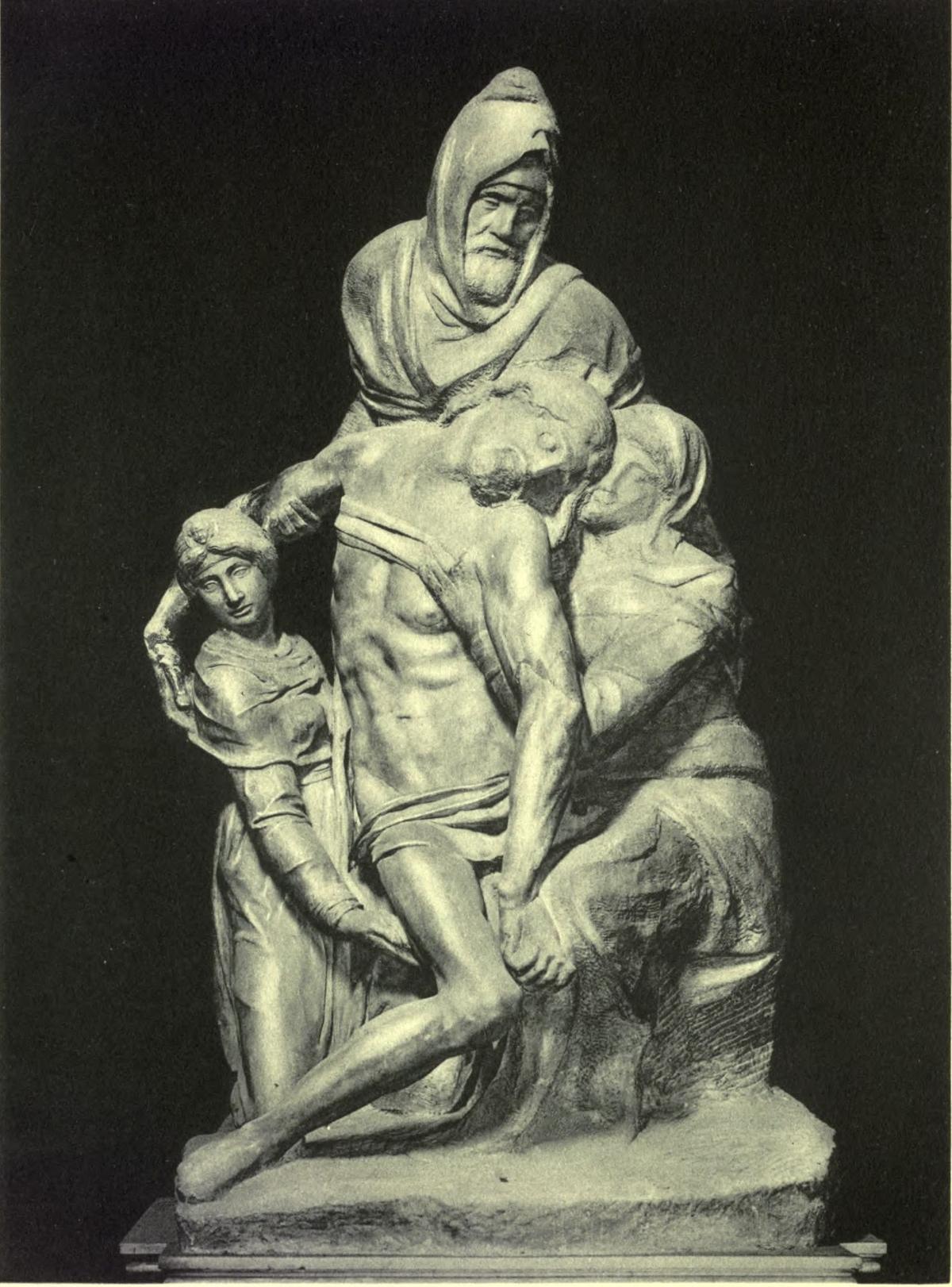
The spirit and genius of Michelangelo could not rest without doing something; and, since he was not able to paint, he set to work on a piece of marble, intending to carve from it four figures in the round and larger than life, including a Dead Christ, for his own delight and to pass the time, and because, as he used to say, the exercise of the hammer kept him healthy in body. This Christ, taken down from the Cross, is supported by Our Lady, by Nicodemus, who bends down and assists her, planted firmly on his feet in a forceful attitude, and by one of the Maries, who also gives her aid, perceiving that the Mother, overcome by grief, is failing in strength and not able to uphold Him. Nor is there anywhere to be seen a dead form equal to that of Christ, who, sinking with the limbs hanging limp, lies in an attitude wholly different, not only from that of any other work by Michelangelo , but from that of any other figure that was ever made. A laborious work is this, a rare achievement in a single stone, and truly divine; but, as will be related hereafter, it remained unfinished, and suffered many misfortunes, although Michelangelo had intended that it should serve to adorn his own tomb, at the foot of that altar where he thought to place it.
It happened in the year 1546 that Antonio da San Gallo died; whereupon, there being now no one to direct the building of S. Pietro, many suggestions were made by the superintendents to the Pope as to who should have it. Finally his Holiness, inspired, I believe, by God, resolved to send for Michelangelo . But he, when asked to take Antonio’s place, refused it, saying, in order to avoid such a burden, that architecture was not his proper art; and in the end, entreaties not availing, the Pope commanded that he should accept it, whereupon, to his great displeasure and against his wish, he was forced to undertake that enterprise. And one day among others that he went to S. Pietro to see the wooden model that San Gallo had made, and to examine the building, he found there the whole San Gallo faction, who, crowding before Michelangelo , said to him in the best terms at their command that they rejoiced that the charge of the building was to be his, and that the model was a field where there would never be any want of pasture. “You speak the truth,” answered Michelangelo , meaning to infer, as he declared to a friend, that it was good for sheep and oxen, who knew nothing of art. And afterwards he used to say publicly that San Gallo had made it wanting in lights, that it had on the exterior too many ranges of columns one above another, and that, with its innumerable projections, pinnacles, and subdivisions of members, it was more akin to the German manner than to the good method of the ancients or to the gladsome and beautiful modern manner; and, in addition to this, that it was possible to save fifty years of time and more than three hundred thousand crowns of money in finishing the building, and to execute it with more majesty, grandeur, and facility, greater beauty and convenience, and better ordered design. This he afterwards proved by a model that he made, in order to bring it to the form in which the work is now seen constructed; and thus he demonstrated that what he said was nothing but the truth. This model cost him twenty-five crowns, and was made in a fortnight; that of San Gallo, as has been related, cost four thousand, and took many years to finish. From this and other circumstances it became evident that that fabric was but a shop and a business for making money, and that it would be continually delayed, with the intention of never finishing it, by those who had undertaken it as a means of profit.
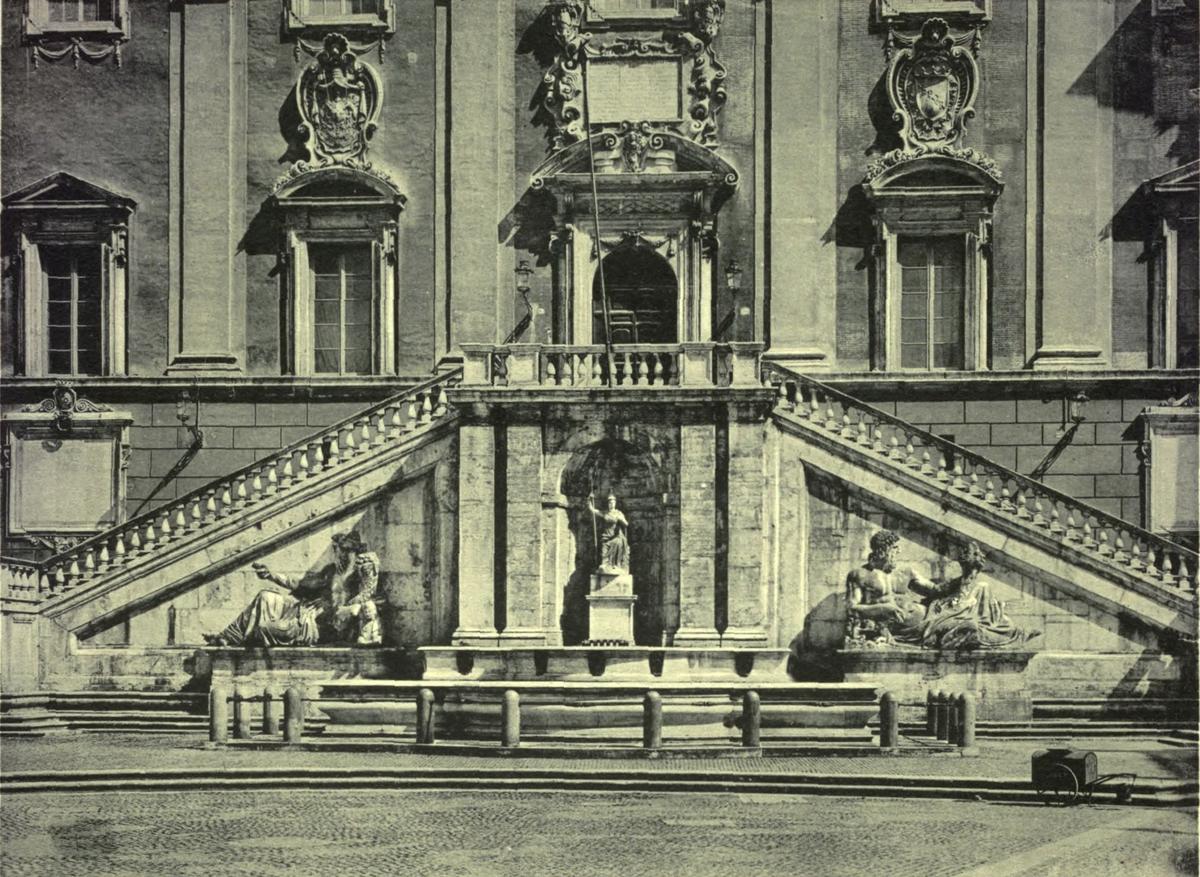
STAIRS OF THE PALACE OF THE SENATORS (After Michelangelo . Rome: The Capitol) Anderson
Such methods did not please our upright Michelangelo , and in order to get rid of all these people, while the Pope was forcing him to accept the office of architect to the work, he said to them openly one day that they should use all the assistance of their friends and do all that they could to prevent him from entering on that office, because, if he were to undertake such a charge, he would not have one of them about the building. Which words, spoken in public, were taken very ill, as may be believed, and were the reason that they conceived a great hatred against him, which increased every day as they saw the whole design being changed, both within and without, so that they would scarcely let him live, seeking out daily new and various devices to harass him, as will be related in the proper place. Finally the Pope issued a Motu-proprio creating him head of that fabric, with full authority, and giving him power to do or undo whatever he chose, and to add, take away, or vary anything at his pleasure; and he decreed that all the officials employed in the work should be subservient to his will. Whereupon Michelangelo , seeing the great confidence and trust that the Pope placed in him, desired, in order to prove his generosity, that it should be declared in the Motu-proprio that he was serving in the fabric for the love of God and without any reward. It is true that the Pope had formerly granted to him the ferry over the river at Parma,[2] which yielded him about six hundred crowns; but he lost it at the death of Duke Pier Luigi Farnese, and in exchange for it he was given a Chancellery at Rimini, a post of less value. About that he showed no concern; and, although the Pope sent him money several times by way of salary, he would never accept it, to which witness is borne by Messer Alessandro Ruffini, Chamberlain to the Pope at that time, and by M. Pier Giovanni Aliotti, Bishop of Forlì. Finally the model that had been made by Michelangelo was approved by the Pope; which model diminished S. Pietro in size, but gave it greater grandeur, to the satisfaction of all those who have judgment, although some who profess to be good judges, which in fact they are not, do not approve of it. He found that the four principal piers built by Bramante, and left by Antonio da San Gallo, which had to support the weight of the tribune, were weak; and these he partly filled up, and beside them he made two winding or spiral staircases, in which is an ascent so easy that the beasts of burden can climb them, carrying all the materials to the very top, and men on horseback, likewise, can go up to the uppermost level of the arches. The first cornice above the arches he constructed of travertine, curving in a round, which is an admirable and graceful thing, and very different from any other; nor could anything better of that kind be done. He also made a beginning with the two great recesses of the transepts; and whereas formerly, under the direction of Bramante, Baldassarre, and Raffaello, as has been related, eight tabernacles were being made on the side towards the Camposanto, and that plan was afterwards followed by San Gallo, Michelangelo reduced these to three, with three chapels in the interior, and above them a vaulting of travertine, and a range of windows giving a brilliant light, which are varied in form and of a sublime grandeur. But, since these things are in existence, and are also to be seen in engraving, not only those of Michelangelo , but those of San Gallo as well, I will not set myself to describe them, for it is in no way necessary. Let it suffice to say that he set himself, with all possible diligence, to cause the work to be carried on in those parts where the fabric was to be changed in design, to the end that it might remain so solid and stable that it might never be changed by another; which was the wise provision of a shrewd and prudent intellect, because it is not enough to do good work, if further precautions be not taken, seeing that the boldness and presumption of those who might be supposed to have knowledge if credit were placed rather in their words than in their deeds, and at times the favour of such as know nothing, may give rise to many misfortunes.
The Roman people, with the sanction of that Pope, had a desire to give some useful, commodious, and beautiful form to the Campidoglio, and to furnish it with colonnades, ascents, and inclined approaches with and without steps, and also with the further adornment of the ancient statues that were already there, in order to embellish that place. For this purpose they sought the advice of Michelangelo , who made them a most beautiful and very rich design, in which, on the side where the Senatore stands, towards the east, he arranged a façade of travertine, and a flight of steps that ascends from two sides to meet on a level space, from which one enters into the centre of the hall of that Palace, with rich curving wings adorned with balusters that serve as supports and parapets. And there, to enrich that part, he caused to be placed on certain bases the two ancient figures in marble of recumbent River Gods, each of nine braccia, and of rare workmanship, one of which is the Tiber and the other the Nile; and between them, in a niche, is to go a Jove. On the southern side, where there is the Palace of the Conservatori, in order that it might be made rectangular, there followed a rich and well varied façade, with a loggia at the foot full of columns and niches, where many ancient statues are to go; and all around are various ornaments, doors, windows, and the like, of which some are already in place. On the other side from this, towards the north, below the Araceli, there is to follow another similar façade; and before it, towards the west, is to be an ascent of baston-like steps, which will be almost level, with a border and parapet of balusters; here will be the principal entrance, with a colonnade, and bases on which will be placed all that wealth of noble statues in which the Campidoglio is now so rich. In the middle of the Piazza, on a base in the form of an oval, is placed the famous bronze horse on which is the statue of Marcus Aurelius, which the same Pope Paul caused to be removed from the Piazza di Laterano, where Sixtus IV had placed it. This edifice is now being made so beautiful that it is worthy to be numbered among the finest works that Michelangelo has executed, and it is being carried to completion at the present day under the direction of M. Tommaso de' Cavalieri, a Roman gentleman who was, and still is, one of the greatest friends that Michelangelo ever had, as will be related hereafter.
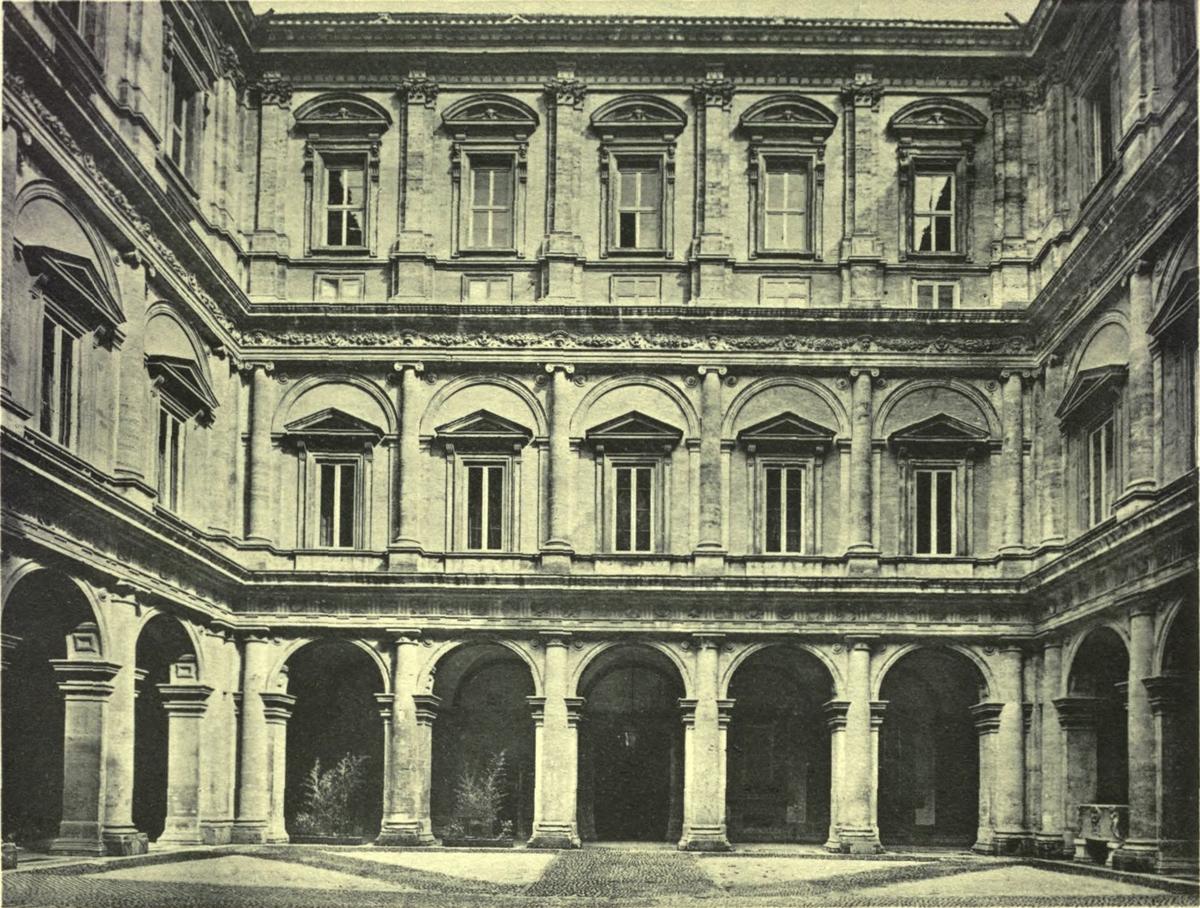
Pope Paul III had caused San Gallo, while he was alive, to carry forward the Palace of the Farnese family, but the great upper cornice, to finish the roof on the outer side, had still to be constructed, and his Holiness desired that Michelangelo should execute it from his own designs and directions. Michelangelo , not being able to refuse the Pope, who so esteemed and favoured him, caused a model of wood to be made, six braccia in length, and of the size that it was to be; and this he placed on one of the corners of the Palace, so that it might show what effect the finished work would have. It pleased his Holiness and all Rome, and that part of it has since been carried to completion which is now to be seen, proving to be the most varied and the most beautiful of all that have ever been known, whether ancient or modern. On this account, after San Gallo was dead, the Pope desired that Michelangelo should have charge of the whole fabric as well; and there he made the great marble window with the beautiful columns of variegated marble, which is over the principal door of the Palace, with a large escutcheon of great beauty and variety, in marble, of Pope Paul III, the founder of that Palace. Within the Palace he continued, above the first range of the court, the two other ranges, with the most varied, graceful, and beautiful windows, ornaments and upper cornice that have ever been seen, so that, through the labours and the genius of that man that court has now become the most handsome in Europe. He widened and enlarged the Great Hall, and set in order the front vestibule, and caused the vaulting of that vestibule to be constructed in a new variety of curve, in the form of a half oval.
Now in that year there was found at the Baths of Antoninus a mass of marble seven braccia in every direction, in which there had been carved by the ancients a Hercules standing upon a mound, who was holding the Bull by the horns, with another figure assisting him, and around that mound various figures of Shepherds, Nymphs, and different animals—a work of truly extraordinary beauty, showing figures so perfect in one single block without any added pieces, which was judged to have been intended for a fountain. Michelangelo advised that it should be conveyed into the second court, and there restored so as to make it spout water in the original manner; all which advice was approved, and the work is still being restored at the present day with great diligence, by order of the Farnese family, for that purpose. At that time, also, Michelangelo made a design for the building of a bridge across the River Tiber in a straight line with the Farnese Palace, to the end that it might be possible to go from that palace to another palace and gardens that they possessed in the Trastevere, and also to see at one glance in a straight line from the principal door which faces the Campo di Fiore, the court, the fountain, the Strada Giulia, the bridge, and the beauties of the other garden, even to the other door which opened on the Strada di Trastevere—a rare work, worthy of that Pontiff and of the judgment, design, and art of Michelangelo .
In the year 1547 died Sebastiano Viniziano, the Friar of the Piombo; and, Pope Paul proposing that the ancient statues of his Palace should be restored, Michelangelo willingly favoured the Milanese sculptor Guglielmo della Porta, a young man of promise, who had been recommended by the above-named Fra Sebastiano to Michelangelo , who, liking his work, presented him to Pope Paul for the restoration of those statues. And the matter went so far forward that Michelangelo obtained for him the office of the Piombo, and he then set to work on restoring the statues, some of which are to be seen in that Palace at the present day. But Guglielmo, forgetting the benefits that he had received from Michelangelo , afterwards became one of his opponents.
In the year 1549 there took place the death of Pope Paul III; whereupon, after the election of Pope Julius III, Cardinal Farnese gave orders for a grand tomb to be made for his kinsman Pope Paul by the hand of Fra Guglielmo, who arranged to erect it in S. Pietro, below the first arch of the new church, beneath the tribune, which obstructed the floor of the church, and was, in truth, not the proper place. Michelangelo advised, most judiciously, that it could not and should not stand there, and the Frate, believing that he was doing this out of envy, became filled with hatred against him; but afterwards he recognized that Michelangelo had spoken the truth, and that the fault was his, in that he had had the opportunity and had not finished the work, as will be related in another place. And to this I can bear witness, for the reason that in the year 1550 I had gone by order of Pope Julius III to Rome to serve him (and very willingly, for love of Michelangelo ), and I took part in that discussion. Michelangelo desired that the tomb should be erected in one of the niches, where there is now the Column of the Possessed, which was the proper place, and I had so gone to work that Julius III was resolving to have his own tomb made in the other niche with the same design as that of Pope Paul, in order to balance that work; but the Frate, who set himself against this, brought it about that his own was never finished after all, and that the tomb of the other Pontiff was also not made; which had all been predicted by Michelangelo .
In the same year Pope Julius turned his attention to having a chapel of marble with two tombs constructed in the Church of S. Pietro a Montorio for Cardinal Antonio di Monte, his uncle, and Messer Fabiano, his grandfather, the first founder of the greatness of that illustrious house. For this work Vasari having made designs and models, Pope Julius, who always esteemed the genius of Michelangelo and loved Vasari, desired that Michelangelo should fix the price between them; and Vasari besought the Pope that he should prevail upon him to take it under his protection. Now Vasari had proposed Simone Mosca for the carvings of this work, and Raffaello da Montelupo for the statues; but Michelangelo advised that no carvings of foliage should be made in it, not even in the architectural parts of the work, saying that where there are to be figures of marble there must not be any other thing. On which account Vasari feared that the work should be abandoned, because it would look poor; but in fact, when he saw it finished, he confessed that Michelangelo had shown great judgment. Michelangelo would not have Montelupo make the statues, remembering how badly he had acquitted himself in those of his own tomb of Julius II, and he was content, rather, that they should be entrusted to Bartolommeo Ammanati, whom Vasari had proposed, although Buonarroti had something of a private grievance against him, as also against Nanni di Baccio Bigio, caused by a reason which, if one considers it well, seems slight enough; for when they were very young, moved rather by love of art than by a desire to do wrong, they had entered with great pains into his house, and had taken from Antonio Mini, the disciple of Michelangelo , many sheets with drawings; but these were afterwards all restored to him by order of the Tribunal of Eight, and, at the intercession of his friend Messer Giovanni Norchiati, Canon of S. Lorenzo, he would not have any other punishment inflicted on them. Vasari, when Michelangelo spoke to him of this matter, said to him, laughing, that it did not seem to him that they deserved any blame, and that he himself, if he had ever been able, would have not taken a few drawings only, but robbed him of everything by his hand that he might have been able to seize, merely for the sake of learning art. One must look kindly, he said, on those who seek after excellence, and also reward them, and therefore such men must not be treated like those who go about stealing money, household property, and other things of value; and so the matter was turned into a jest. This was the reason that a beginning was made with the work of the Montorio, and that in the same year Vasari and Ammanati went to have the marble conveyed from Carrara to Rome for the execution of that work.
At that time Vasari was with Michelangelo every day; and one morning the Pope in his kindness gave them both leave that they might visit the Seven Churches on horseback (for it was Holy Year), and receive the Pardon in company. Whereupon, while going from one church to another, they had many useful and beautiful conversations on art and every industry, and out of these Vasari composed a dialogue, which will be published at some more favourable opportunity, together with other things concerning art. In that year Pope Julius III confirmed the Motu-proprio of Pope Paul III with regard to the building of S. Pietro; and although much evil was spoken to him of Michelangelo by the friends of the San Gallo faction, in the matter of that fabric of S. Pietro, at that time the Pope would not listen to a word, for Vasari had demonstrated to him (as was the truth) that Michelangelo had given life to the building, and also persuaded his Holiness that he should do nothing concerned with design without the advice of Michelangelo . This promise the Pope kept ever afterwards, for neither at the Vigna Julia did he do anything without his counsel, nor at the Belvedere, where there was built the staircase that is there now, in place of the semicircular staircase that came forward, ascending in eight steps, and turned inwards in eight more steps, erected in former times by Bramante in the great recess in the centre of the Belvedere. And Michelangelo designed and caused to be built the very beautiful quadrangular staircase, with balusters of peperino-stone, which is there at the present day.
Vasari had finished in that year the printing of his work, the Lives of the Painters, Sculptors, and Architects, in Florence. Now he had not written the Life of any living master, although some who were old were still alive, save only of Michelangelo ; and in the book were many records of circumstances that Vasari had received from his lips, his age and his judgment being the greatest among all the craftsmen. Giorgio therefore presented the work to him, and he received it very gladly; and not long afterwards, having read it, Michelangelo sent to him the following sonnet, written by himself, which I am pleased to include in this place in memory of his loving-kindness:
Se con lo stile o co‘ colori havete Alla Natura pareggiato l’Arte, Anzi a quella scemato il pregio in parte, Che ‘l bel di lei più bello a noi rendete, Poichè con dotta man posto vi siete A più degno lavoro, a vergar carte, Quel che vi manca a lei di pregio in parte, Nel dar vita ad altrui tutto togliete. Che se secolo alcuno omai contese In far bell’opre, almen cedale, poi Che convien‘, ch’al prescritto fine arrive. Or le memorie altrui già spente accese Tornando fate, or che sien quelle, e voi, Mal grado d'esse, eternalmente vive.
Vasari departed for Florence, and left to Michelangelo the charge of having the work founded in the Montorio. Now Messer Bindo Altoviti, the Consul of the Florentine colony at that time, was much the friend of Vasari, and on this occasion Giorgio said to him that it would be well to have this work erected in the Church of S. Giovanni de‘ Fiorentini, and that he had already spoken of it with Michelangelo , who would favour the enterprise; and that this would be a means of giving completion to that church. This proposal pleased Messer Bindo, and, being very intimate with the Pope, he urged it warmly upon him, demonstrating that it would be well that the chapel and the tombs which his Holiness was having executed for the Montorio should be placed in the Church of S. Giovanni de’ Fiorentini; adding that the result would be that with this occasion and this spur the Florentine colony would undertake such expenditure that the church would receive its completion, and, if his Holiness were to build the principal chapel, the other merchants would build six chapels, and then little by little all the rest. Whereupon the Pope changed his mind, and, although the model for the work was already made and the price arranged, went to the Montorio and sent for Michelangelo , to whom Vasari was writing every day, receiving answers from him according to the opportunities presented in the course of affairs. Michelangelo then wrote to Vasari, on the first day of August in 1550, of the change that the Pope had made; and these are his words, written in his own hand:
Rome.
“My dear Messer Giorgio,
“With regard to the founding of the work at S. Pietro a Montorio, and how the Pope would not listen to a word, I wrote you nothing, knowing that you are kept informed by your man here. Now I must tell you what has happened, which is as follows. Yesterday morning the Pope, having gone to the said Montorio, sent for me. I met him on the bridge, on his way back, and had a long conversation with him about the tombs allotted to you; and in the end he told me that he was resolved that he would not place those tombs on that mount, but in the Church of the Florentines. He sought from me my opinion and also designs, and I encouraged him not a little, considering that by this means the said church would be finished. Respecting your three letters received, I have no pen wherewith to answer to such exalted matters, but if I should rejoice to be in some sort what you make me, I should rejoice for no other reason save that you might have a servant who might be worth something. But I do not marvel that you, who restore dead men to life, should lengthen the life of the living, or rather, that you should steal from death for an unlimited period those barely alive. To cut this short, such as I am, I am wholly yours,
“Michelangelo Buonarroti.”
While these matters were being discussed, and the Florentine colony was seeking to raise money, certain difficulties arose, on account of which they came to no decision, and the affair grew cold. Meanwhile, Vasari and Ammanati having by this time had all the marbles quarried at Carrara, a great part of them were sent to Rome, and with them Ammanati, through whom Vasari wrote to Buonarroti that he should ascertain from the Pope where he wanted the tomb, and, after receiving his orders, should have the work begun. The moment that Michelangelo received the letter, he spoke to his Holiness; and with his own hand he wrote the following resolution to Vasari:
“13th of October, 1550.
“My dear Messer Giorgio,
“The instant that Bartolommeo arrived here, I went to speak to the Pope, and, having perceived that he wished to begin the work once more at the Montorio, in the matter of the tombs, I looked for a mason from S. Pietro. ‘Tantecose’[3] heard this and insisted on sending one of his choosing, and I, to avoid contending with a man who commands the winds, have retired from the matter, because, he being a light-minded person, I would not care to be drawn into any entanglement. Enough that in my opinion there is no more thought to be given to the Church of the Florentines. Fare you well, and come back soon. Nothing else occurs to me.”
Michelangelo used to call Monsignor di Forlì “Tantecose,” because he insisted on doing everything himself. Being Chamberlain to the Pope, he had charge of the medals, jewels, cameos, little figures in bronze, pictures, and drawings, and desired that everything should depend on him. Michelangelo was always anxious to avoid the man, because he had been constantly working against the master’s interests, and therefore Buonarroti feared lest he might be drawn into some entanglement by the intrigues of such a man. In short, the Florentine colony lost a very fine opportunity for that church, and God knows when they will have such another; and to me it was an indescribable grief. I have desired not to omit to make this brief record, to the end that it may be seen that our Michelangelo always sought to help his fellow-countrymen and his friends, and also art.
Vasari had scarcely returned to Rome, when, before the beginning of the year 1551, the San Gallo faction arranged a conspiracy against Michelangelo , whereby the Pope was to hold an assembly in S. Pietro, and to summon together the superintendents and all those who had the charge of the work, in order to show to the Pope, by means of false calumnies, that Michelangelo had ruined that fabric, because, he having already built the apse of the King, where there are the three chapels, and having executed these with the three windows above, they, not knowing what was to be done with the vaulting, with feeble judgment had given the elder Cardinal Salviati and Marcello Cervini, who afterwards became Pope, to understand that S. Pietro was being left with little light. Whereupon, all being assembled, the Pope said to Michelangelo that the deputies declared that the apse would give little light, and he answered: “I would like to hear these deputies speak in person.” Cardinal Marcello replied: “We are here.” Then Michelangelo said to him: “Monsignore, above these windows, in the vaulting, which is to be made of travertine, there are to be three others.” “You have never told us that,” said the Cardinal. And Michelangelo answered: “I am not obliged, nor do I intend to be obliged, to say either to your Highness or to any other person what I am bound or desirous to do. Your office is to obtain the money and to guard it from thieves, and the charge of the design for the building you must leave to me.” And then, turning to the Pope, he said: “Holy Father, you see what my gains are, and that if these fatigues that I endure do not profit me in my mind, I am wasting my time and my work.” The Pope, who loved him, laid his hands on his shoulders, and said: “You shall profit both in mind and in body; do not doubt it.” Michelangelo having thus been able to get rid of those persons, the Pope came to love him even more; and he commanded him and Vasari that on the day following they should both present themselves at the Vigna Julia, in which place his Holiness had many discussions with him, and they carried that work almost to the condition of perfect beauty in which it now is; nor did the Pope discuss or do anything in the matter of design without Michelangelo ’s advice and judgment. And, among other things, since Michelangelo went often with Vasari to visit him, the Pope insisted, once when he was at the fountain of the Acqua Vergine with twelve Cardinals, after Buonarroti had come up; the Pope, I say, insisted very strongly that he should sit beside him, although he sought most humbly to excuse himself; thus always honouring his genius as much as lay in his power.
The Pope caused him to make the model of a façade for a palace that his Holiness desired to build beside S. Rocco, intending to avail himself of the Mausoleum of Augustus for the rest of the masonry; and, as a design for a façade, there is nothing to be seen that is more varied, more ornate, or more novel in manner and arrangement, for the reason that, as has been seen in all his works, he never consented to be bound by any law, whether ancient or modern, in matters of architecture, as one who had a brain always able to discover things new and well-varied, and in no way less beautiful. That model is now in the possession of Duke Cosimo de' Medici, who had it as a present from Pope Pius IV when he went to Rome; and he holds it among his dearest treasures. That Pope had such respect for Michelangelo , that he was constantly taking up his defence against Cardinals and others who sought to calumniate him, and he desired that other craftsmen, however able and renowned they might be, should always go to seek him at his house; such, indeed, were the regard and reverence that he felt for him, that his Holiness did not venture, lest he might annoy him, to call upon Michelangelo for many works which, although he was old, he could have executed.
As far back as the time of Paul III Michelangelo had made a beginning with the work of refounding, under his own direction, the Ponte S. Maria at Rome, which had been weakened by the constant flow of water and by age, and was falling into ruin. The refounding was contrived by Michelangelo by means of caissons, and by making stout reinforcements against the piers; and already he had carried a great part of it to completion, and had spent large sums on wood and travertine on behalf of the work, when, in the time of Julius III, an assembly was held by the Clerks of the Chamber with a view to making an end of it, and a proposal was made among them by the architect Nanni di Baccio Bigio, saying that if it were allotted by contract to him it would be finished in a short time and without much expense; and this they suggested on the pretext, as it were, of doing a favour to Michelangelo and relieving him of a burden, because he was old, alleging that he gave no thought to it, and that if matters remained as they were the end would never be seen. The Pope, who little liked being troubled, not thinking what the result might be, gave authority to the Clerks of the Chamber that they should have charge of the work, as a thing pertaining to them; and then, without Michelangelo hearing another word about it, they gave it with all those materials, without any conditions, to Nanni, who gave no attention to the reinforcements, which were necessary for the refounding, but relieved the bridge of some weight, in consequence of having seen a great quantity of travertine wherewith it had been flanked and faced in ancient times, the result of which was to give weight to the bridge and to make it stouter, stronger, and more secure. In place of that he used gravel and other materials cast with cement, in such a manner that no defect could be seen in the inner part of the work, and on the outer side he made parapets and other things, insomuch that to the eye it appeared as if made altogether new; but it was made lighter all over and weakened throughout. Five years afterwards, when the flood of the year 1557 came down, it happened that the bridge collapsed in such a manner as to make known the little judgment of the Clerks of the Chamber and the loss that Rome suffered by departing from the counsel of Michelangelo , who predicted the ruin of the bridge many times to me and to his other friends. Thus I remember that he said to me, when we were passing there together on horseback, “Giorgio, this bridge is shaking under us; let us spur our horses, or it may fall while we are upon it.”
But to return to the narrative interrupted above; when the work of the Montorio was finished, and that much to my satisfaction, I returned to Florence to re-enter the service of Duke Cosimo, which was in the year 1554. The departure of Vasari grieved Michelangelo , and likewise Giorgio, for the reason that Michelangelo ’s adversaries kept harassing him every day, now in one way and now in another; wherefore they did not fail to write to one another daily. And in April of the same year, Vasari giving him the news that Leonardo, the nephew of Michelangelo , had had a male child, that they had accompanied him to baptism with an honourable company of most noble ladies, and that they had revived the name of Buonarroto, Michelangelo answered in a letter to Vasari in these words:
“Dear Friend Giorgio,
“I have had the greatest pleasure from your letter, seeing that you still remember the poor old man, and even more because you were present at the triumph which, as you write, you witnessed in the birth of another Buonarroto; for which intelligence I thank you with all my heart and soul. But so much pomp does not please me, for man should not be laughing when all the world is weeping. It seems to me that Leonardo should not make so much rejoicing over a new birth, with all that gladness which should be reserved for the death of one who has lived well. Do not marvel if I delay to answer; I do it so as not to appear a merchant. As for the many praises that you send me in your letter, I tell you that if I deserved a single one of them, it would appear to me that in giving myself to you body and soul, I had truly given you something, and had discharged some infinitesimal part of the debt that I owe you; whereas I recognize you every hour as my creditor for more than I can repay, and, since I am an old man, I can now never hope to be able to square the account in this life, but perhaps in the next. Wherefore I pray you have patience, and remain wholly yours. Things here are much as usual.”
Already, in the time of Paul III, Duke Cosimo had sent Tribolo to Rome to see if he might be able to persuade Michelangelo to return to Florence, in order to give completion to the Sacristy of S. Lorenzo. But Michelangelo excused himself because, having grown old, he could not support the burden of such fatigues, and demonstrated to him with many reasons that he could not leave Rome. Whereupon Tribolo finally asked him about the staircase of the library of S. Lorenzo, for which Michelangelo had caused many stones to be prepared, but there was no model of it nor any certainty as to the exact form, and, although there were some marks on a pavement and some other sketches in clay, the true and final design could not be found. However, no matter how much Tribolo might beseech him and invoke the name of the Duke, Michelangelo would never answer a word save that he remembered nothing of it. Orders were given to Vasari by Duke Cosimo that he should write to Michelangelo , requesting him to write saying what final form that staircase was to have; in the hope that through the friendship and love that he bore to Vasari, he would say something that might lead to some solution and to the completion of the work. Vasari wrote to Michelangelo the mind of the Duke, saying that the execution of all that was to be done would fall to him; which he would do with that fidelity and care with which, as Michelangelo knew, he was wont to treat such of his works as he had in charge. Wherefore Michelangelo sent the directions for making the above-named staircase in a letter by his own hand on the 28th of September, 1555.
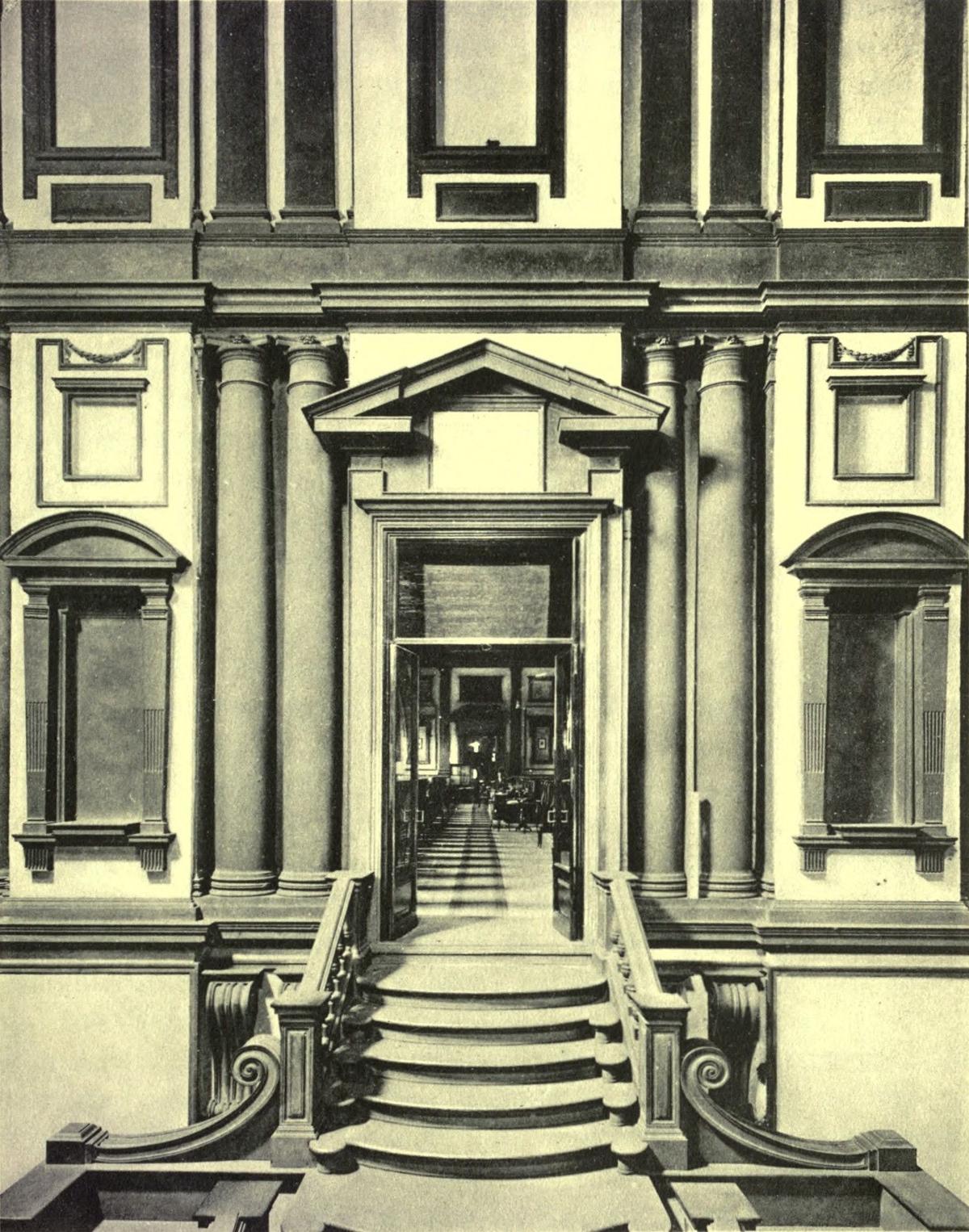
“Messer Giorgio, Dear Friend,
“Concerning the staircase for the library, of which so much has been said to me, you may believe that if I could remember how I had designed it, I would not need to be entreated. There does, indeed, come back to my mind, like a dream, a certain staircase; but I do not believe that it is exactly the one which I conceived at that time, because it comes out so stupid. However, I will describe it here. Take a quantity of oval boxes, each one palm in depth, but not of equal length and breadth. The first and largest place on the pavement at such a distance from the wall of the door as may make the staircase easy or steep, according to your pleasure. Upon this place another, which must be so much smaller in every direction as to leave on the first one below as much space as the foot requires in ascending; diminishing and drawing back the steps one after another towards the door, in accord with the ascent. And the diminution of the last step must reduce it to the proportion of the space of the door. The said part of the staircase with the oval steps must have two wings, one on one side and one on the other, with corresponding steps but not oval. Of these the central flight shall serve as the principal staircase, and from the centre of the staircase to the top the curves of the said wings shall meet the wall; but from the centre down to the pavement they shall stand, together with the whole staircase, at a distance of about three palms from the wall, in such a manner that the basement of the vestibule shall not be obstructed in any part, and every face shall be left free. I am writing nonsense; but I know well that you will find something to your purpose.”
Michelangelo also wrote to Vasari in those days that Julius III being dead, and Marcellus elected, the faction that was against him, in consequence of the election of the new Pontiff, had again begun to harass him. Which hearing, and not liking these ways, the Duke caused Giorgio to write and tell him that he should leave Rome and come to live in Florence, where the Duke did not desire more than his advice and designs at times for his buildings, and that he would receive from that lord all that he might desire, without doing anything with his own hand. Again, there were carried to him by M. Leonardo Marinozzi, the private Chamberlain of Duke Cosimo, letters written by his Excellency; and so also by Vasari. But then, Marcellus being dead, and Paul IV having been elected, by whom once again numerous offers had been made to him from the very beginning, when he went to kiss his feet, the desire to finish the fabric of S. Pietro, and the obligation by which he thought himself bound to that task, kept him back; and, employing certain excuses, he wrote to the Duke that for the time being he was not able to serve him, and to Vasari a letter in these very words:
“Messer Giorgio, my dear Friend,
“I call God to witness how it was against my will and under the strongest compulsion that I was set to the building of S. Pietro in Rome by Pope Paul III, ten years ago. Had they continued to work at that fabric up to the present day, as they were doing then, I would now have reached such a point in the undertaking that I might be thinking of returning home; but for want of money it has been much retarded, and is still being retarded at the time when it has reached the most laborious and difficult stage, insomuch that to abandon it now would be nothing short of the greatest possible disgrace and sin, losing the reward of the labours that I have endured in those ten years for the love of God. I have made you this discourse in answer to your letter, and also because I have a letter from the Duke that has made me marvel much that his Excellency should have deigned to write so graciously; for which I thank God and his Excellency to the best of my power and knowledge. I wander from the subject, because I have lost my memory and my wits, and writing is a great affliction to me, for it is not my art. The conclusion is this: to make you understand what would be the result if I were to abandon the fabric and depart from Rome; firstly, I would please a number of thieves, and secondly, I would be the cause of its ruin, and perhaps, also, of its being suspended for ever.”
Continuing to write to Giorgio, Michelangelo said to him, to excuse himself with the Duke, that he had a house and many convenient things at his disposal in Rome, which were worth thousands of crowns, in addition to being in danger of his life from disease of the kidneys, colic, and the stone, as happens to every old person, and as could be proved by Maestro Realdo, his physician, from whom he congratulated himself on having his life, after God; that for these reasons he was not able to leave Rome, and, finally, that he had no heart for anything but death. He besought Vasari, as he did in several other letters that Giorgio has by his hand, that he should recommend him to the Duke for pardon, in addition to what he wrote to the Duke, as I have said, to excuse himself. If Michelangelo had been able to ride, he would have gone straightway to Florence, whence, I believe, he would never have consented to depart in order to return to Rome, so much was he influenced by the tenderness and love that he felt for the Duke; but meanwhile he gave his attention to working at many parts of the above-named fabric, in order so to fix the form that it might never again be changed. During this time certain persons had informed him that Pope Paul IV was minded to make him alter the façade of the chapel where the Last Judgment is, because, he said, those figures showed their nakedness too shamelessly. When, therefore, the mind of the Pope was made known to Michelangelo , he answered: “Tell the Pope that it is no great affair, and that it can be altered with ease. Let him put the world right, and every picture will be put right in a moment.” The office of the Chancellery of Rimini was taken away from Michelangelo , but he would never speak of this to the Pope, who did not know it; and it was taken away from him by the Pope’s Cup-bearer, who sought to have a hundred crowns a month given to him in respect of the fabric of S. Pietro, and caused a month’s payment to be taken to his house, but Michelangelo would not accept it. In the same year took place the death of Urbino, his servant, or rather, as he may be called, and as he had been, his companion. This man came to live with Michelangelo in Florence in the year 1530, after the siege was finished, when his disciple Antonio Mini went to France; and he rendered very faithful service to Michelangelo , insomuch that in twenty-six years that faithful and intimate service brought it about that Michelangelo made him rich and so loved him, that in this, Urbino’s last illness, old as he was, he nursed him and slept in his clothes at night to watch over him. Wherefore, after he was dead, Vasari wrote to Michelangelo to console him, and he answered in these words:
“My dear Messer Giorgio,
“I am scarce able to write, but, in reply to your letter, I shall say something. You know how Urbino died, wherein God has shown me very great grace, although it is also a grave loss and an infinite grief to me. This grace is that whereas when living he kept me alive, dying he has taught me to die not with regret, but with a desire for death. I have had him twenty-six years, and have found him a very rare and faithful servant; and now, when I had made him rich and was looking to him as the staff and repose of my old age, he has flown from me, nor is any hope left to me but to see him again in Paradise. And of this God has granted a sign in the happy death that he died, in that dying grieved him much less than leaving me in this traitorous world with so many afflictions; although the greater part of me is gone with him, and nothing is left me but infinite misery. I commend myself to you.”
Michelangelo was employed in the time of Pope Paul IV on many parts of the fortifications of Rome, and also by Salustio Peruzzi, to whom that Pope, as has been related elsewhere, had given the charge of executing the great portal of the Castello di S. Angelo, which is now half ruined; and he occupied himself in distributing the statues of that work, examining the models of the sculptors, and correcting them. At that time the French army approached near to Rome, and Michelangelo thought that he was like to come to an evil end together with that city; whereupon he resolved to fly from Rome with Antonio Franzese of Castel Durante, whom Urbino at his death had left in his house as his servant, and went secretly to the mountains of Spoleto, where he visited certain seats of hermits. Meanwhile Vasari wrote to him, sending him a little work that Carlo Lenzoni, a citizen of Florence, had left at his death to Messer Cosimo Bartoli, who was to have it printed and dedicated to Michelangelo ; which, when it was finished, Vasari sent in those days to Michelangelo , and he, having received it, answered thus:
September 18, 1556.
“Messer Giorgio, dear Friend,
“I have received Messer Cosimo’s little book, which you send to me, and this shall be a letter of thanks. I pray you to give them to him, and send him my compliments.
“I have had in these days great discomfort and expense, but also great pleasure, in visiting the hermits in the mountains of Spoleto, insomuch that less than half of me has returned to Rome, seeing that in truth there is no peace to be found save in the woods. I have nothing more to tell you. I am glad that you are well and happy, and I commend myself to you.”
Michelangelo used to work almost every day, as a pastime, at that block with the four figures of which we have already spoken; which block he broke into pieces at this time for these reasons, either because it was hard and full of emery, and the chisel often struck sparks from it, or it may have been that the judgment of the man was so great that he was never content with anything that he did. A proof that this is true is that there are few finished statues to be seen out of all that he executed in the prime of his manhood, and that those completely finished were executed by him in his youth, such as the Bacchus, the Pietà in S. Maria della Febbre, the Giant of Florence, and the Christ of the Minerva, which it would not be possible to increase or diminish by as little as a grain of millet without spoiling them; and the others, with the exception of the Dukes Giuliano and Lorenzo, Night, Dawn, and Moses, with the other two, the whole number of these statues not amounting in all to eleven, the others, I say, were all left unfinished, and, moreover, they are many, Michelangelo having been wont to say that if he had had to satisfy himself in what he did, he would have sent out few, nay, not one. For he had gone so far with his art and judgment, that, when he had laid bare a figure and had perceived in it the slightest degree of error, he would set it aside and run to lay his hand on another block of marble, trusting that the same would not happen to the new block; and he often said that this was the reason that he gave for having executed so few statues and pictures. This Pietà, when it was broken, he presented to Francesco Bandini. Now at this time Tiberio Calcagni, a Florentine sculptor, had become much the friend of Michelangelo by means of Francesco Bandini and Messer Donato Giannotti; and being one day in Michelangelo ’s house, where there was the Pietà, all broken, after a long conversation he asked him for what reason he had broken it up and destroyed labours so marvellous, and he answered that the reason was the importunity of his servant Urbino, who kept urging him every day to finish it, besides which, among other things, a piece of one of the elbows of the Madonna had been broken off, and even before that he had taken an aversion to it, and had had many misfortunes with it by reason of a flaw that was in the marble, so that he lost his patience and began to break it up; and he would have broken it altogether into pieces if his servant Antonio had not besought him that he should present it to him as it was. Whereupon Tiberio, having heard this, spoke to Bandini, who desired to have something by the hand of Michelangelo , and Bandini contrived that Tiberio should promise to Antonio two hundred crowns of gold, and prayed Michelangelo to consent that Tiberio should finish it for Bandini with the assistance of models by his hand, urging that thus his labour would not be thrown away. Michelangelo was satisfied, and then made them a present of it. The work was carried away immediately, and then put together again and reconstructed with I know not what new pieces by Tiberio; but it was left unfinished by reason of the death of Bandini, Michelangelo , and Tiberio. At the present day it is in the possession of Pier Antonio Bandini, the son of Francesco, at his villa on Monte Cavallo. But to return to Michelangelo ; it became necessary to find some work in marble on which he might be able to pass some time every day with the chisel, and another piece of marble was put before him, from which another Pietà had been already blocked out, different from the first and much smaller.
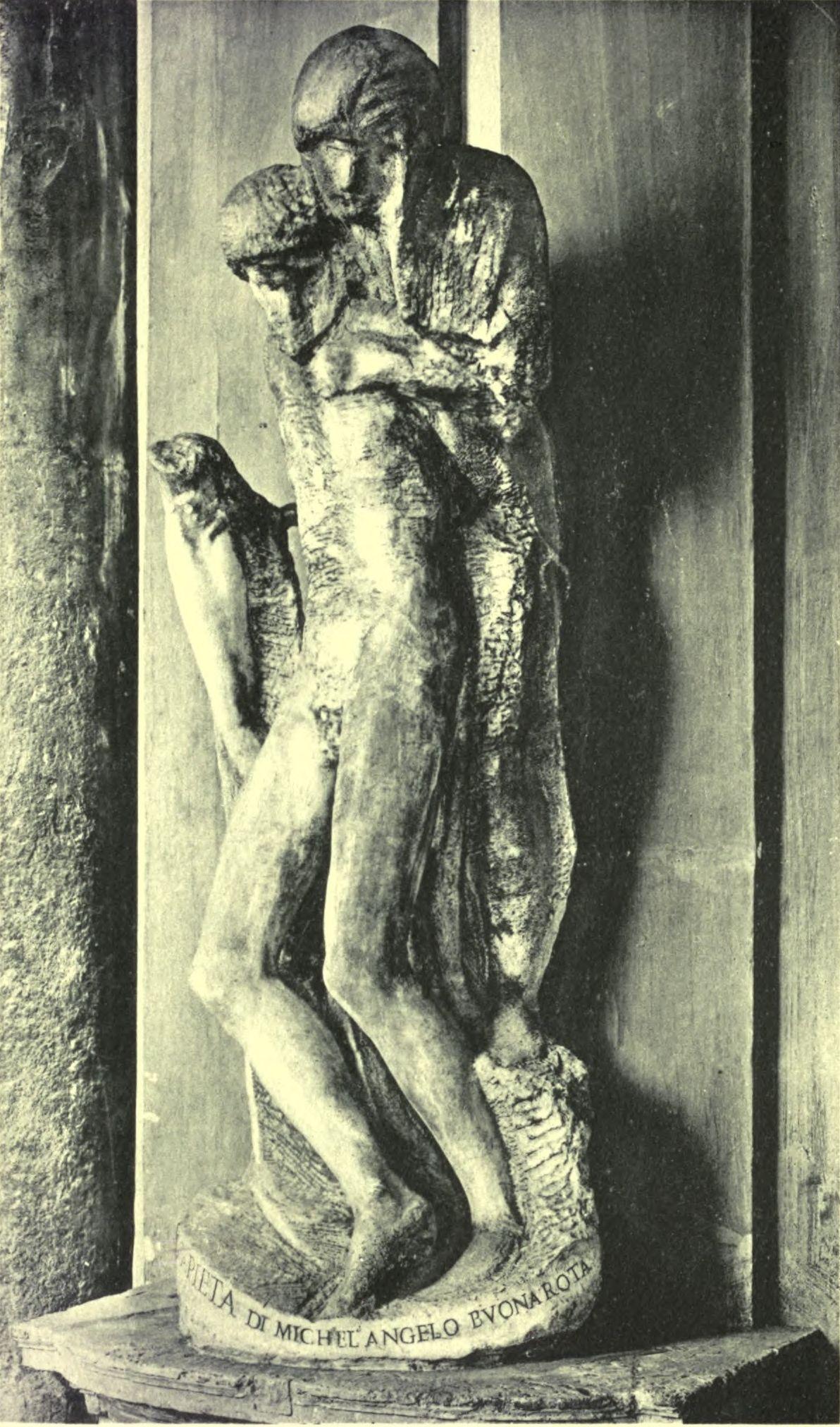
There had entered into the service of Paul IV, and also into the charge of the fabric of S. Pietro, the architect Pirro Ligorio, and he was now once more harassing Michelangelo , going about saying that he had sunk into his second childhood. Wherefore, angered by such treatment, he would willingly have returned to Florence, and, having delayed to return, he was again urged in letters by Giorgio, but he knew that he was too old, having now reached the age of eighty-one. Writing at that time to Vasari by his courier, and sending him various spiritual sonnets, he said that he was come to the end of his life, that he must be careful where he directed his thoughts, that by reading he would see that he was at his last hour, and that there arose in his mind no thought upon which was not graved the image of death; and in one letter he said:
“It is God’s will, Vasari, that I should continue to live in misery for some years. I know that you will tell me that I am an old fool to wish to write sonnets, but since many say that I am in my second childhood, I have sought to act accordingly. By your letter I see the love that you bear me, and you may take it as certain that I would be glad to lay these feeble bones of mine beside those of my father, as you beg me to do; but by departing from here I would be the cause of the utter ruin of the fabric of S. Pietro, which would be a great disgrace and a very grievous sin. However, when it is so firmly established that it can never be changed, I hope to do all that you ask me, if it be not a sin to keep in anxious expectation certain gluttons that await my immediate departure.”
With this letter was the following sonnet, also written in his own hand:
Giunto è già ‘l corso della vita mia Con tempestoso mar’ per fragil barca Al comun porto, ov‘a render’ si varca Conto e ragion‘ d’ogni opra trista e pia. Onde l‘affetuosa fantasia, Che l’arte mi fece idolo e monarca, Conosco or‘ ben’ quant‘era d’error‘ carca, E quel ch’a mal suo grado ognun‘ desia. Gli amorosi pensier’ già vani e lieti Che sien‘or’, s’a due morti mi avvicino? D‘una so certo, e l’altra mi minaccia. Nè pinger‘ nè scolpir’ sia più che quieti L‘anima volta a quello Amor Divino Ch’aperse a prender' noi in Croce le braccia.
Whereby it was evident that he was drawing towards God, abandoning the cares of art on account of the persecution of his malignant fellow-craftsmen, and also through the fault of certain overseers of the fabric, who would have liked, as he used to say, to dip their hands in the chest. By order of Duke Cosimo, a reply was written to Michelangelo by Vasari in a letter of few words, exhorting him to repatriate himself, with a sonnet corresponding in the rhymes. Michelangelo would willingly have left Rome, but he was so weary and aged, that although, as will be told below, he was determined to go back, while the spirit was willing the flesh was weak, and that kept him in Rome. It happened in June of the year 1557, he having made a model for the vault that was to cover the apse, which was being built of travertine in the Chapel of the King, that, from his not being able to go there as he had been wont, an error arose, in that the capomaestro took the measurements over the whole body of the vault with one single centre, whereas there should have been a great number; and Michelangelo , as the friend and confidant of Vasari, sent him designs by his own hand, with these words written at the foot of two of them:
“The centre marked with red was used by the capomaestro over the body of the whole vault; then, when he began to pass to the half-circle, which is at the summit of the vault, he became aware of the error which that centre was producing, as may be seen here in the design, marked in black. With this error the vault has gone so far forward, that we have to displace a great number of stones, for in that vault there is being placed no brick-work, but all travertine, and the diameter of the circle, without the cornice that borders it, is twenty-two palms. This error, after I had made an exact model, as I do of everything, has been caused by my not being able, on account of my old age, to go there often; so that, whereas I believed that the vault was now finished, it will not be finished all this winter, and, if it were possible to die of shame and grief, I should not be alive now. I pray you account to the Duke for my not being at this moment in Florence.”
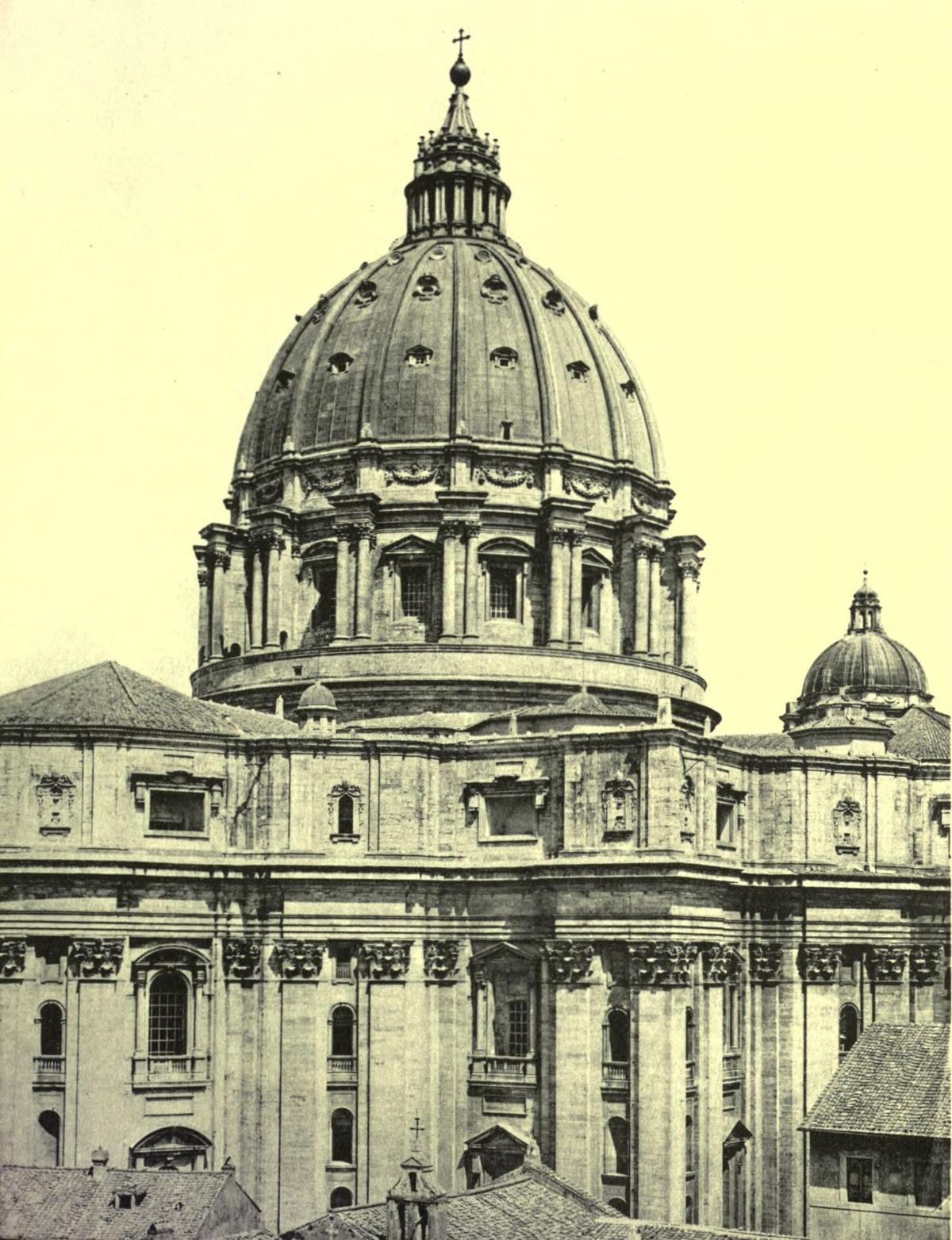
(After Michelangelo . Rome) Alinari
And continuing in the other design, where he had drawn the plan, he said this:
“Messer Giorgio,
“To the end that it may be easier to understand the difficulty of the vault by observing its rise from the level of the ground, let me explain that I have been forced to divide it into three vaults, corresponding to the windows below divided by pilasters; and you see that they go pyramidally into the centre of the summit of the vault, as also do the base and sides of the same. It was necessary to regulate them with an infinite number of centres, and there are in them so many changes in various directions, from point to point, that no fixed rule can be maintained. And the circles and squares that come in the middle of their deepest parts have to diminish and increase in so many directions, and to go to so many points, that it is a difficult thing to find the true method. Nevertheless, having the model, such as I make for everything, they should never have committed so great an error as to seek to regulate with one single centre all those three shells; whence it has come about that we have been obliged with shame and loss to pull down, as we are still doing, a great number of stones. The vault, with its sections and hewn stone-work, is all of travertine, like all the rest below; a thing not customary in Rome.”
Michelangelo was excused by Duke Cosimo, hearing of these misfortunes, from coming to Florence; the Duke saying to him that his contentment and the continuation of S. Pietro were more dear to him than anything in the world, and that he should rest in peace. Whereupon Michelangelo wrote to Vasari, on the same sheet in which he thanked the Duke to the best of his power and knowledge for such kindness, saying, “God give me grace that I may be able to serve him with this my poor person, for my memory and my brain are gone to await him elsewhere.” The date of this letter was August in the year 1557. Thus, then, Michelangelo learned that the Duke esteemed his life and his honour more than he did himself, who so revered him. All these things, and many more that it is not necessary to mention, we have in our possession, written in his hand.
Michelangelo by this time was reduced to a feeble condition, and it was evident that little was being done in S. Pietro, now that he had carried on a great part of the frieze of the windows within, and of the double columns without, which curve above the great round cornice[4] where the cupola is to be placed, as will be related; and he was exhorted and urged by his greatest friends, such as the Cardinal of Carpi, Messer Donato Giannotti, Francesco Bandini, Tommaso de' Cavalieri, and Lottino that, since he saw the delay in the raising of the cupola, he should at least make a model of it. He stayed many months without making up his mind to this, but in the end he made a beginning, and then little by little constructed a small model in clay, from which, as an exemplar, and from the plans and profiles that he had drawn, it might be possible afterwards to make a larger one of wood. This, having made a beginning with it, he caused to be constructed in little more than a year by Maestro Giovanni Franzese, with much study and pains; and he made it on such a scale that the smaller proportions of the model, measured by the old Roman palm, corresponded with complete exactness to those of the large work, he having fashioned with diligence in that model all the members of columns, bases, capitals, doors, windows, cornices, projections, and likewise every least thing, knowing that in such a work no less should be done, for in all Christendom, nay, in all the world, there is not to be found or seen any fabric more ornate or more grand. And I cannot but think that, if we have given up time to noting smaller things, it is even more useful, and also our duty, to describe this manner of design for building the structure of this tribune with the form, order, and method that Michelangelo thought to give it; wherefore with such brevity as we may we will give a simple description of it, to the end that, if it should ever be the fate of this work, which God forbid, to be disturbed by the envy and malice of presumptuous persons after the death of Michelangelo , even as we have seen it disturbed up to the present during his lifetime, these my writings, such as they may be, may be able to assist the faithful who are to be the executors of the mind of that rare man, and also to restrain the malignant desires of those who may seek to alter it, and so at one and the same time assist, delight, and open the minds of those beautiful intellects that are the friends of this profession and regard it as their joy.
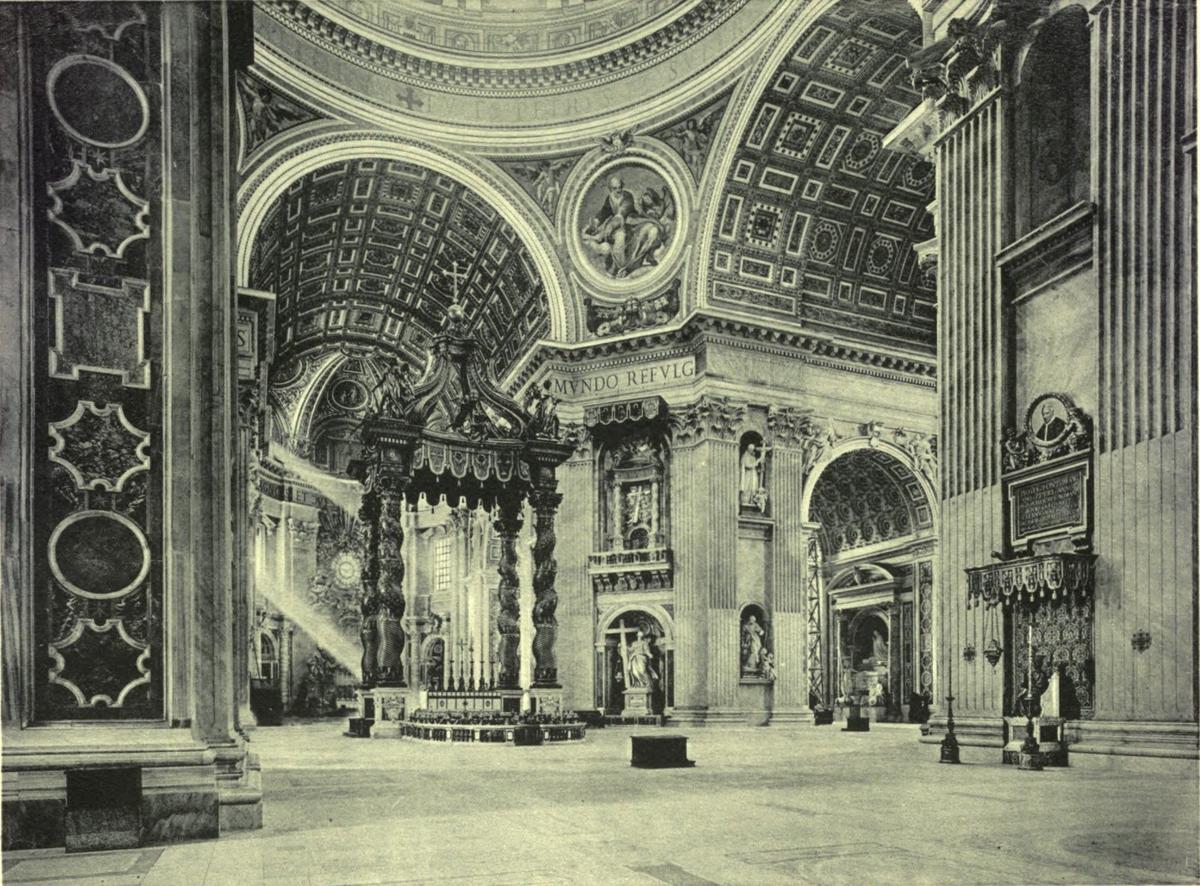
I must begin by saying that according to this model, made under the direction of Michelangelo , I find that in the great work the whole space within the tribune will be one hundred and eighty-six palms, speaking of its width from wall to wall above the great cornice of travertine that curves in a round in the interior, resting on the four great double piers that rise from the ground with their capitals carved in the Corinthian Order, accompanied by their architrave, frieze, and cornice, likewise of travertine; which great cornice, curving right round over the great niches, rests supported upon the four great arches of the three niches and of the entrance, which form the cross of the building. Then there begins to spring the first part of the tribune, the rise of which commences in a basement of travertine with a platform six palms broad, where one can walk; and this basement curves in a round in the manner of a well, and its thickness is thirty-three palms and eleven inches, the height to the cornice eleven palms and ten inches, the cornice over it about eight palms, and its projection six and a half palms. Into this basement you enter, in order to ascend the tribune, by four entrances that are over the arches of the niches, and the thickness of the basement is divided into three parts; that on the inner side is fifteen palms, that on the outer side is eleven palms, and that in the centre is seven palms and eleven inches, which make up the thickness of thirty-three palms and eleven inches. The space in the centre is hollow and serves as a passage, which is two squares in height and curves in a continuous round, with a barrel-shaped vault; and in line with the four entrances are eight doors, each of which rises in four steps, one of them leading to the level platform of the cornice of the first basement, six palms and a half in breadth, and another leading to the inner cornice that curves round the tribune, eight palms and three-quarters broad, on which platforms, by each door, you can walk conveniently both within and without the edifice, and from one entrance to another in a curve of two hundred and one palms, so that, the sections being four, the whole circuit comes to be eight hundred and four palms. We now have to ascend from the level of this basement, upon which rest the columns and pilasters, and which forms the frieze of the windows within all the way round, being fourteen palms and one inch in height, and around it, on the outer side, there is at the foot a short order of cornice-work, and so also at the top, which does not project more than ten inches, and all of travertine; and so in the thickness of the third part, above that on the inner side, which we have described as fifteen palms thick, there is made in every quarter-section a staircase, one half of which ascends in one direction and the second half in another, the width being four palms and a quarter; and this staircase leads to the level of the columns. Above this level there begin to rise, in line with the solid parts of the basement, eighteen large piers all of travertine, each adorned with two columns on the outer side and pilasters on the inner, as will be described below, and between the piers are left the spaces where there are to be all the windows that are to give light to the tribune. These piers, on the sides pointing towards the central point of the tribune, are thirty-six palms in extent, and on the front sides nineteen and a half. Each of them, on the outer side, has two columns, the lowest dado of which is eight palms and three-quarters broad and one palm and a half high, the base five palms and eight inches broad and ... palms and eleven inches high, the shaft of the column forty-three and a half palms high, five palms and six inches thick at the foot and four palms and nine inches at the top, the Corinthian capital six palms and a half high, with the crown of mouldings nine palms. Of these columns three quarters are to be seen, and the other quarter is merged into the corner, with the accompaniment of the half of a pilaster that makes a salient angle on the inner side, and this is accompanied in the central inner space by the opening of an arched door, five palms wide and thirteen palms and five inches high, from the summit of which to the capitals of the pilasters and columns there is a filling of solid masonry, serving as a connection with two other pilasters that are similar to those that form a salient angle beside the columns. These two pilasters correspond to the others, and adorn the sides of sixteen windows that go right round the tribune, each with a light twelve palms and a half wide and about twenty-two palms high. These windows are to be adorned on the outer side with varied architraves two palms and three-quarters high, and on the inner side they are to be adorned with orders likewise varied, with pediments and quarter-rounds; and they are wide without and more narrow within, and so, also, they are sloped away at the foot of the inner side, so that they may give light over the frieze and cornice. Each of them is bordered by two flat pilasters that correspond in height to the columns without, so that there come to be thirty-six columns without and thirty-six pilasters within; over which pilasters is the architrave, which is four palms and three-quarters in height, the frieze four and a half, and the cornice four and two-thirds, with a projection of five palms; and above this is to go a range of balusters, so that one may be able to walk all the way round there with safety. And in order that it may be possible to climb conveniently from the level where the columns begin, another staircase ascends in the same line within the thickness of the part that is fifteen palms wide, in the same manner and of the same width, with two branches or ascents, all the way up to the summit of the columns, with their capitals, architraves, friezes, and cornices; insomuch that, without obstructing the light of the windows, these stairs pass at the top into a spiral staircase of the same breadth, which finally reaches the level where the turning of the tribune is to begin.
All this order, distribution, and ornamentation is so well varied, commodious, rich, durable, and strong, and serves so well to support the two vaults of the cupola that is to be turned upon it, that it is a very ingenious thing, and it is all so well considered and then executed in masonry, that there is nothing to be seen by the eyes of one who has knowledge and understanding that is more pleasing, more beautiful, or wrought with greater mastery, both on account of the binding together and mortising of the stones and because it has in it in every part strength and eternal life, and also because of the great judgment wherewith he contrived to carry away the rain-water by many hidden channels, and, finally, because he brought it to such perfection, that all other fabrics that have been built and seen up to the present day appear as nothing in comparison with the grandeur of this one. And it has been a very great loss that those whose duty it was did not put all their power into the undertaking, for the reason that, before death took away from us that rare man, we should have seen that beautiful and terrible structure already raised.
Up to this point has Michelangelo carried the masonry of the work; and it only remains to make a beginning with the vaulting of the tribune, of which, since the model has come down to us, we shall proceed to describe the design that he has left to the end that it may be carried out. He turned the curve of this vault on three points that make a triangle, in this manner:
The stairs in the centre between one shell and the other are constructed in this form; from the level where the springing of the vault begins they rise in each of the four sections, and each ascends from two entrances, the stairs intersecting one another in the form of an X, until they have covered the half of the arch marked C, on the upper side of the shell, when, having ascended straight up the half of that arch, the remaining space is then easily climbed circle after circle and step after step in a direct line, until finally one arrives at the eye of the cupola, where the rise of the lantern begins, around which, in accord with the diminution of the compartments that spring above the piers, there is a smaller range of double pilasters and windows similar to those that are constructed in the interior, as will be described below.
Over the first great cornice within the tribune there begin at the foot the compartments for the recesses that are in the vault of the tribune, which are formed by sixteen projecting ribs. These at the foot are as broad as the breadth of the two pilasters which at the lower end border each window below the vault of the tribune, and they rise, diminishing pyramidally, as far as the eye of the lantern; at the foot they rest on pedestals of the same breadth and twelve palms high, and these pedestals rest on the level platform of the cornice which goes in a circle right round the tribune. Above this, in the recessed spaces between the ribs, there are eight large ovals, each twenty-nine palms high, and over them a number of straight-sided compartments that are wider at the foot and narrower at the top, and twenty-four palms high, and then, the ribs drawing together, there comes above each straight-sided compartment a round fourteen palms high; so that there come to be eight ovals, eight straight-sided compartments, and eight rounds, each range forming recesses that grow more shallow in succession. The ground of all these displays extraordinary richness, for Michelangelo intended to make the ribs and the ornaments of the said ovals, straight-sided compartments, and rounds, all corniced in travertine.
It remains for us to make mention of the surface and adornment of the arch on that side of the vault where the roofing is to go, which begins to rise from a base twenty-five palms and a half high, which has at the foot a basement that has a projection of two palms, as have the crowning mouldings at the top. The covering or roofing with which he proposed to cover it is of lead, such as covers the roof of the old S. Pietro at the present day, and is divided into sixteen sections from one solid base to another, each base beginning where the two columns end, which are one on either side of it. In each of these sections, in the centre, he made two windows to give light to the inner space where the ascent of the stairs is, between the two shells, so that in all they are thirty-two. These, by means of brackets that support a quarter-round, he made projecting from the roof in such a manner as to protect the lofty and novel view-point from the rain. In a line with the centre of the solid base between each two columns, above which was the crowning cornice, sprang a rib, one to each, wider at the foot and narrowing at the top; in all sixteen ribs, five palms broad, in the centre of each of which was a quadrangular channel one palm and a half wide, within which is formed an ascent of steps about one palm high, by which to ascend or descend between the platform at the foot and the summit where the lantern begins. These are to be built of travertine and constructed with mortisings, to the end that the joins may be protected against water and ice during times of rain.
The design for the lantern is reduced in the same proportion as all the rest of the work, so that, taking lines round the circumference, everything comes to diminish in exact accord, and with proportionate measurements it rises as a simple temple with round columns two by two, like those on the solid bases below. These have pilasters to correspond to them, and one can walk all the way round and see from the central spaces between the pilasters, where the windows are, the interior of the tribune and the church. Above this, architrave, frieze, and cornice curve in a round, projecting over each pair of columns; and over these columns, in a line with them, spring some caulicoles, which, together with some niches that divide them, rise to find the end of the lantern, which, beginning to draw together, grows gradually narrower for a third of its height, in the manner of a round pyramid, until it reaches the ball, upon which, as the final crown of the structure, goes the cross. Many particulars and minute details I might have mentioned, such as air-holes for protection against earthquakes, water-conduits, the various lights, and other conveniences, but I omit them because the work is not yet come to completion, being content to have touched on the principal parts as well as I have been able. For, since every part is in existence and can be seen, it is enough to have made this brief sketch, which is a great light to him who has no knowledge of the structure.
The completion of this model caused the greatest satisfaction not only to all his friends, but to all Rome, the form of the fabric having been thus settled and established. It then came to pass that Paul IV died, and after him was elected Pius IV, who, while causing the building of the little palace in the wood of the Belvedere to be continued by Pirro Ligorio, who remained architect to the Palace, made many gracious offers and advances to Michelangelo . The Motu-proprio originally received by Michelangelo from Paul III, and then from Julius III and Paul IV, in respect of the fabric of S. Pietro, he confirmed in his favour, and he restored to him a part of the revenues and allowances taken away by Paul IV, employing him in many of his works of building; and in his time he caused the fabric of S. Pietro to be carried on vigorously. He made use of Michelangelo , in particular, in preparing a design for the tomb of the Marchese Marignano, his brother, which, destined to be erected in the Duomo of Milan, was allotted by his Holiness to the Chevalier Leone Lioni of Arezzo, a most excellent sculptor and much the friend of Michelangelo ; the form of which tomb will be described in the proper place.
At this time the Chevalier Leone made a very lively portrait of Michelangelo in a medal, and to please him he fashioned on the reverse a blind man led by a dog, with these letters around:
DOCEBO INIQUOS VIAS TUAS, ET IMPII AD TE CONVERTENTUR.
And Michelangelo , since it pleased him much, presented him a model in wax of Hercules crushing Antæus, by his own hand, with certain of his designs. Of Michelangelo we have no other portraits but two in painting, one by the hand of Bugiardini and the other by Jacopo del Conte, one in bronze executed in full-relief by Daniello Ricciarelli, and this one by the Chevalier Leone; from which portraits so many copies have been made, that I have seen a good number in many places in Italy and in foreign parts.
The same year Cardinal Giovanni de' Medici, the son of Duke Cosimo, went to Rome to receive the hat from Pius IV, and it fell to Vasari, as his servant and familiar friend, to go with him; which Vasari went there willingly and stayed about a month, in order to enjoy Michelangelo , who received him with great affection and was always with him. Vasari had taken with him, by order of his Excellency, a model in wood of the whole Ducal Palace of Florence, together with designs of the new apartments that had been built and painted by him; which Michelangelo desired to see both in the model and in the designs, since, being old, he was not able to see the works themselves. These works, which were abundant and well varied, with different inventions and fancies, began with the Castration of Uranus and continued in stories of Saturn, Ops, Ceres, Jove, Juno, and Hercules, each room having one of these names, with the stories in various compartments; even as the other chambers and halls, which were beneath these, had the names of the heroes of the House of Medici, beginning with the elder Cosimo, and continuing with Lorenzo, Leo X, Clement VII, Signor Giovanni, Duke Alessandro, and Duke Cosimo, in each of which were not only the stories of their actions, but also portraits of them, of their children, and of all the ancients renowned in statesmanship, in arms, and in letters, taken from the life. Of these Vasari had written a Dialogue in which he explained all the stories, the end of the whole invention, and how the fables above harmonized with the stories below; which was read to Michelangelo by Annibale Caro, and he took the greatest pleasure in it. This Dialogue, when Vasari shall have more time, will be published.
The result of all this was as follows. Vasari was desirous of setting his hand to the Great Hall, and since, as has been said elsewhere, the ceiling was low, making it stunted and wanting in lights, he had a desire to raise that ceiling. Now the Duke would not make up his mind to give him leave that it should be raised; not that the Duke feared the cost, as was seen afterwards, but rather the danger of raising the beams of the roof thirteen braccia. However, like a man of judgment, his Excellency consented that the advice of Michelangelo should be taken, and Michelangelo , having seen in that model the Hall as it then was, and afterwards, all the beams having been removed and replaced by other beams with a new invention in the ceiling and walls, the same Hall as it has since been made, with the invention of the stories likewise designed therein, liked it and straightway became not a judge but a supporter, and the rather as he saw the facile method of raising the beams and the roof, and the plan for executing the whole work in a short time. Wherefore, on Vasari’s return, he wrote to the Duke that he should carry out that undertaking, since it was worthy of his greatness.
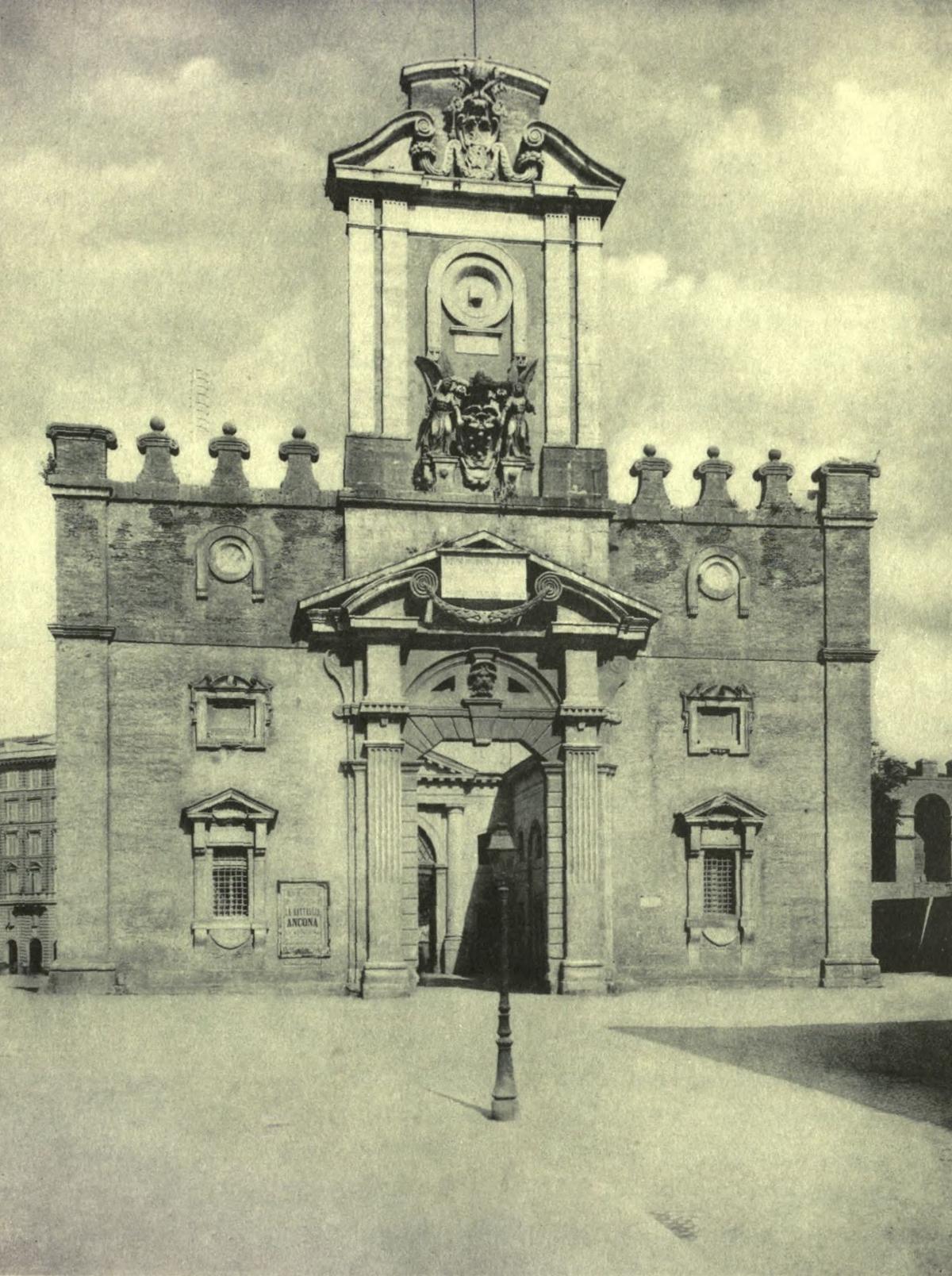
The same year Duke Cosimo went to Rome with the Lady Duchess Leonora, his consort, and Michelangelo , after the Duke’s arrival, went straightway to see him. The Duke, after receiving him with many endearments, caused him, out of respect for his great genius, to sit by his side, and with much familiarity talked to him of all that he had caused to be done in painting and sculpture at Florence, and also of all that he was minded to have done, and in particular of the Hall; and Michelangelo again encouraged and reassured him in that matter, lamenting, since he loved that Lord, that he was not young enough to be able to serve him. His Excellency said that he had discovered the way to work porphyry, a thing which Michelangelo could not believe, and the Duke therefore sent him, as has been related in the first chapter of the Treatise on Theory, the head of Christ wrought by the sculptor Francesco del Tadda, at which he was astonished; and he visited the Duke several times the while that he stayed in Rome, to his vast satisfaction. He did the same a short time afterwards when the most Illustrious Don Francesco de' Medici, the Duke’s son, went there, in whom Michelangelo took much delight from the marks of regard and affection shown to him by his most Illustrious Excellency, who spoke with him always cap in hand, having infinite reverence for so rare a man; and Michelangelo wrote to Vasari that it vexed him to be old and infirm, for he would have liked to do something for that Lord, but he was going about trying to buy some beautiful antique to send to him in Florence.
Being requested at this time by the Pope for a design for the Porta Pia, Michelangelo made three, all fantastic and most beautiful, of which the Pope chose the least costly for putting into execution; and it is now to be seen erected there, with much credit to him. Perceiving the inclination of the Pope, and hoping that he would restore the other gates of Rome, he made many other designs for him; and he did the like, at the request of the same Pontiff, in the matter of the new Church of S. Maria degli Angeli in the Baths of Diocletian, in order to convert them into a temple for the use of Christians. A design by his hand prevailed over many others made by excellent architects, being executed with such beautiful considerations for the convenience of the Carthusian Friars, who have now carried it almost to completion, that it caused his Holiness and all the prelates and lords of the Court to marvel at the judgment of the lovely conceptions that he had drawn, availing himself of all the skeleton of those baths, out of which was seen formed a most beautiful temple, with an entrance surpassing the expectations of all the architects; from which he acquired infinite praise and honour. For that place, also, he designed for his Holiness a Ciborium of the Sacrament in bronze, cast for the most part by Maestro Jacopo Ciciliano, an excellent bronze-caster, who makes his works come out very delicate and fine, without any roughness, so that they can be polished with little labour; in which field he is a rare master, and gave much satisfaction to Michelangelo .
